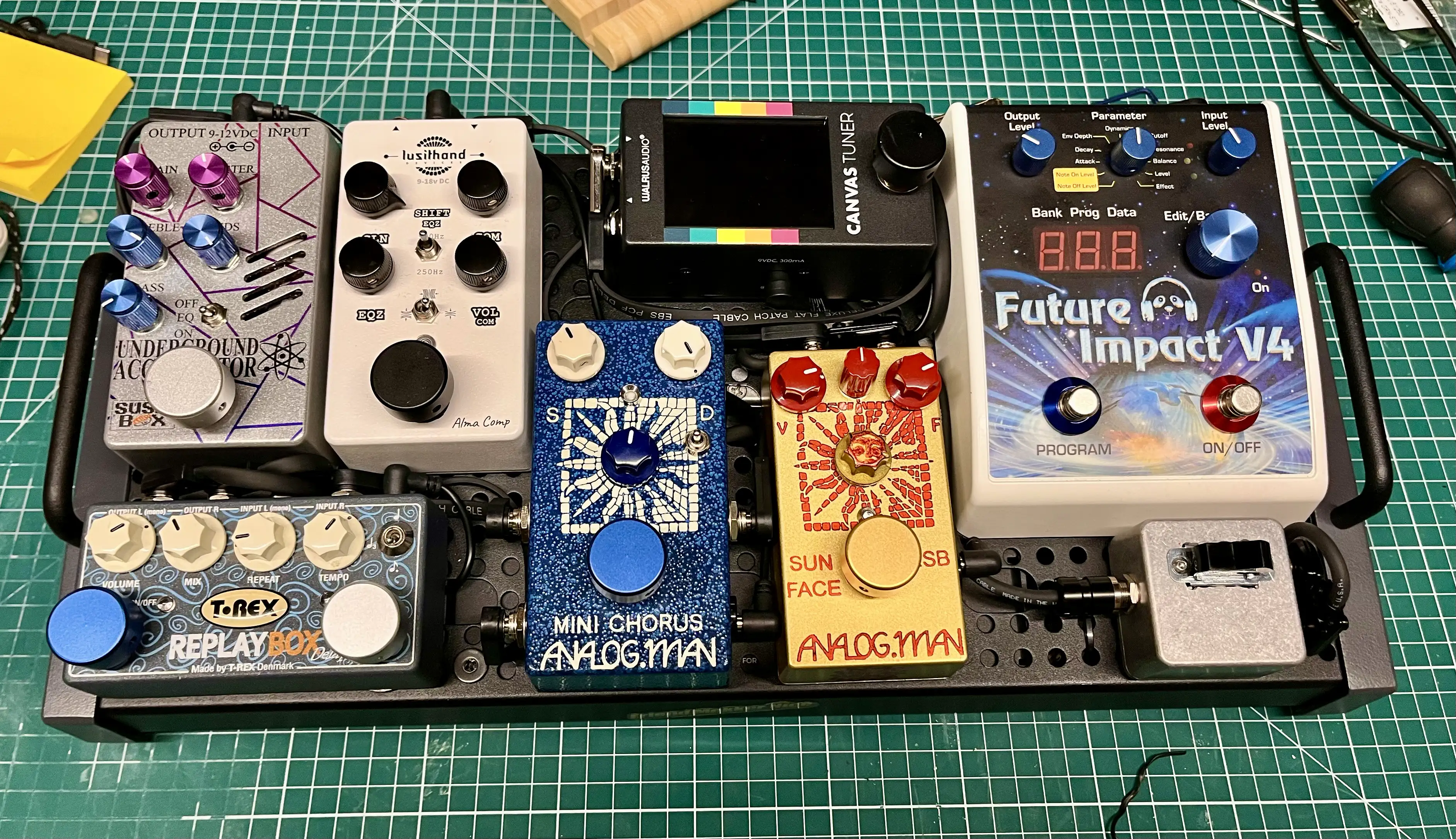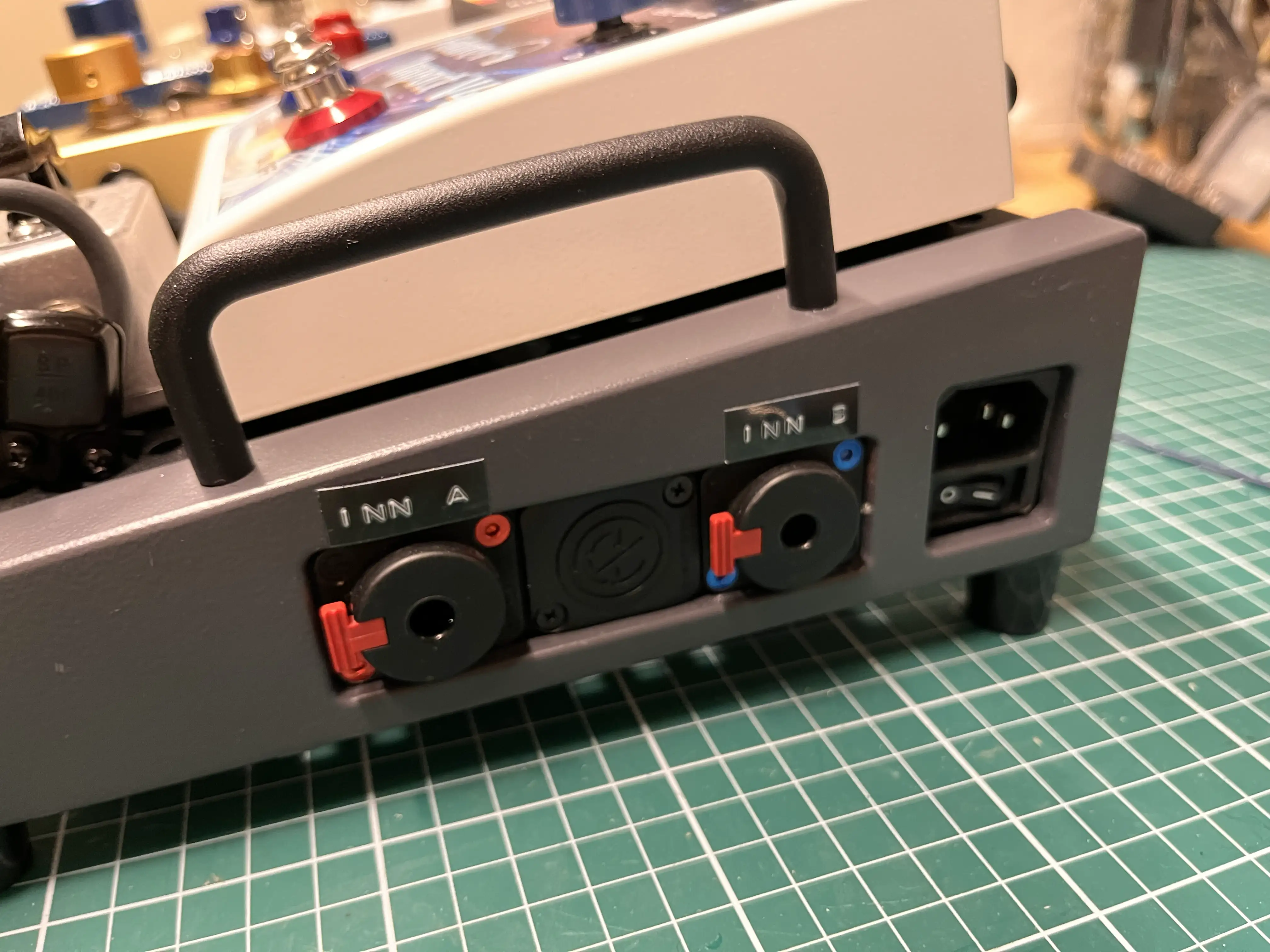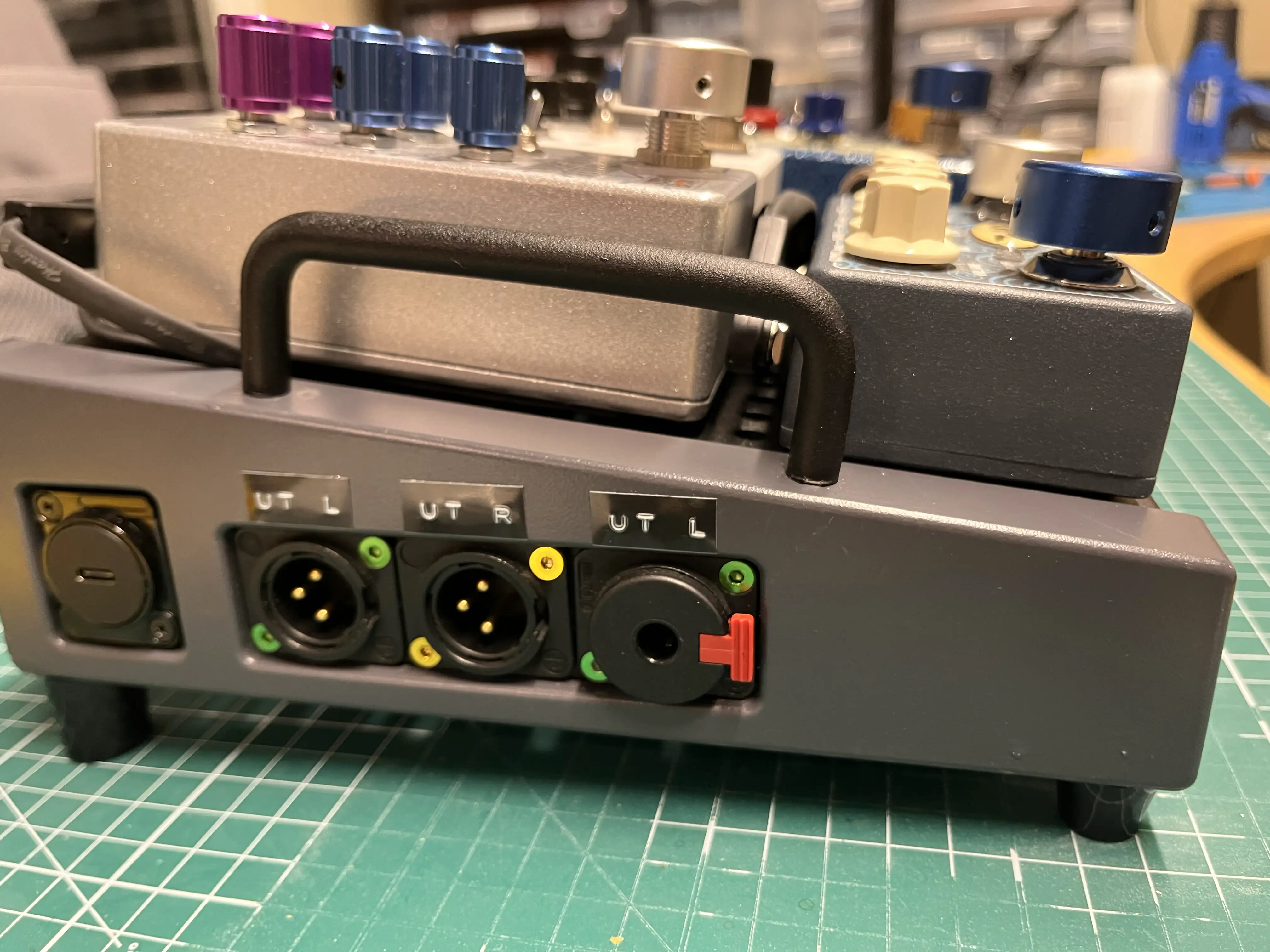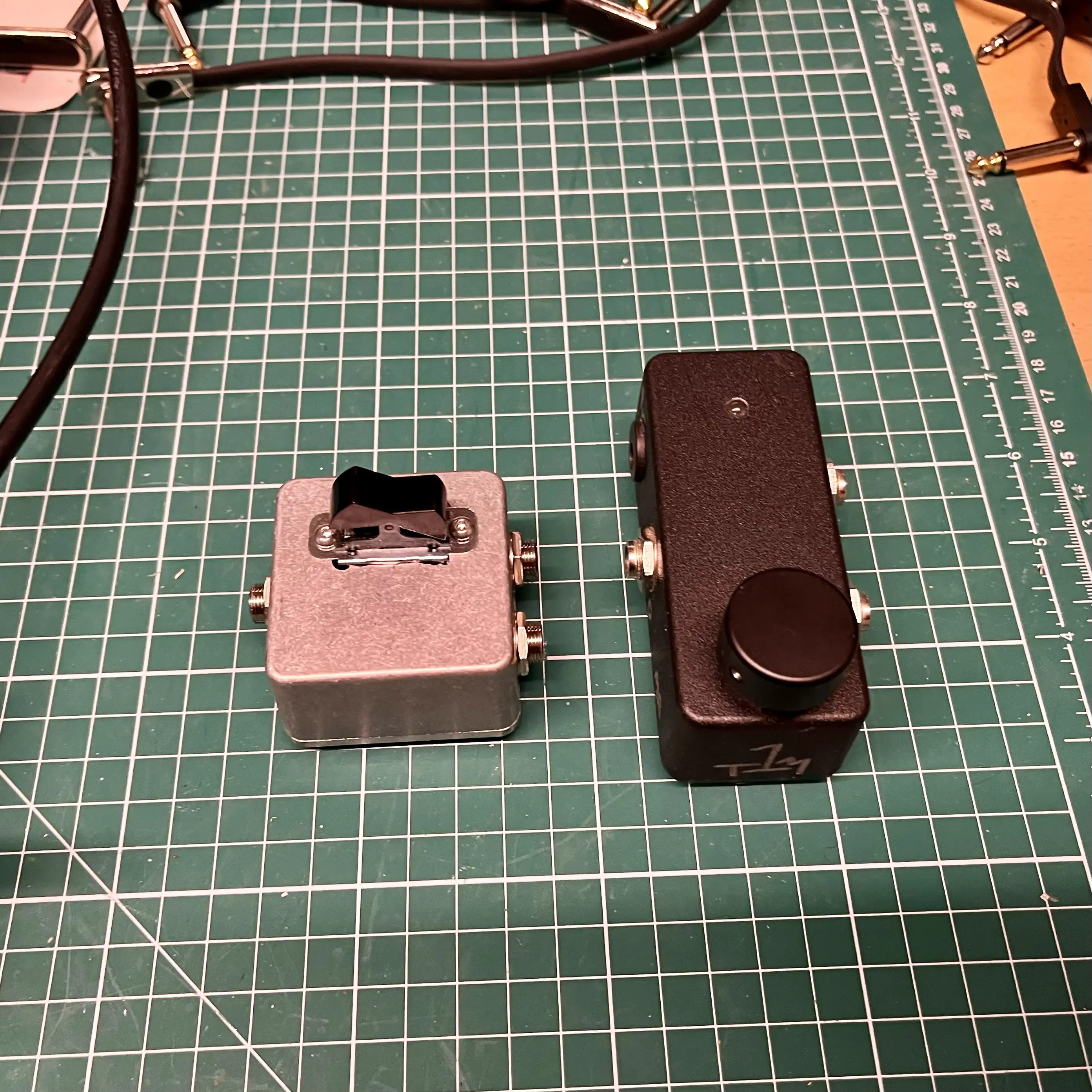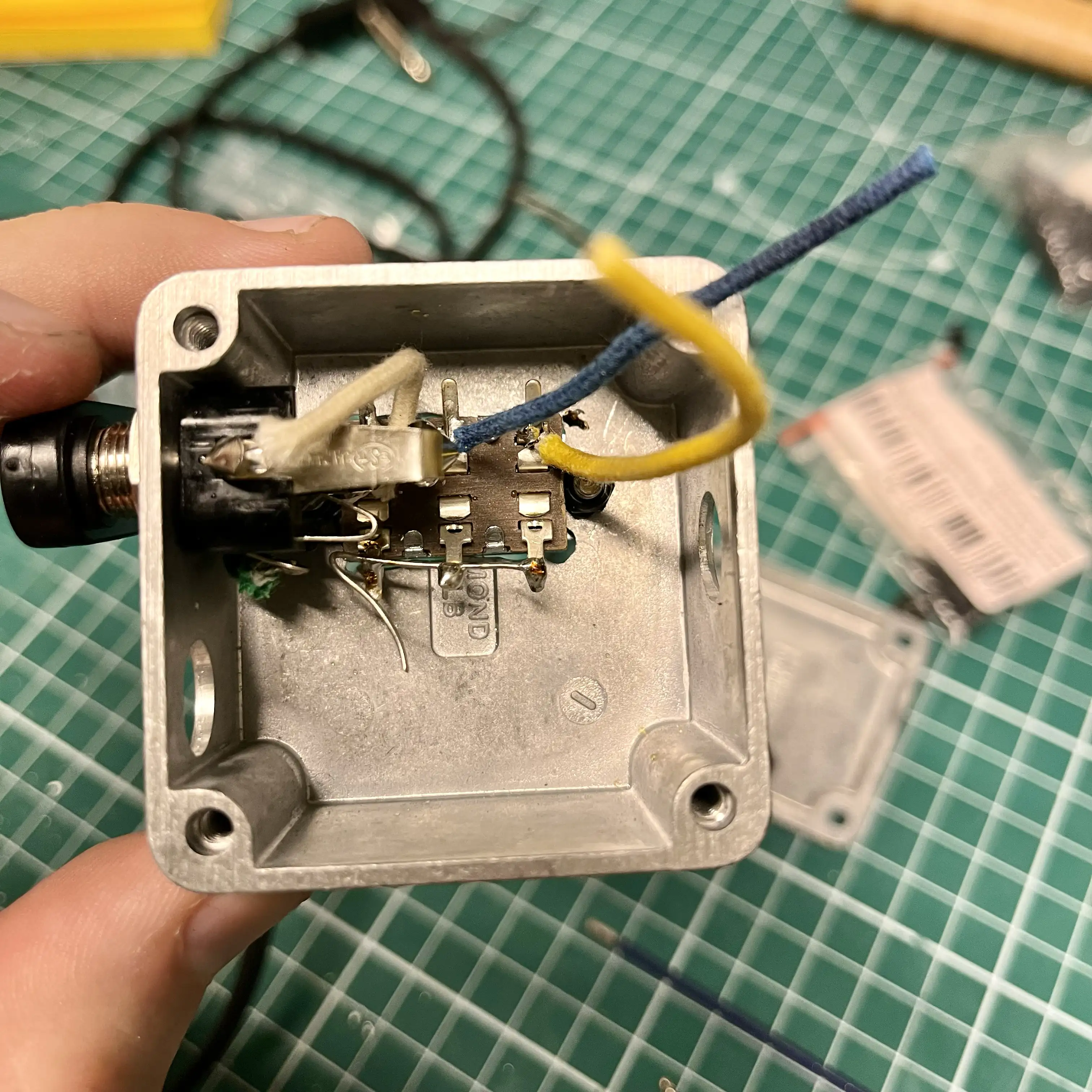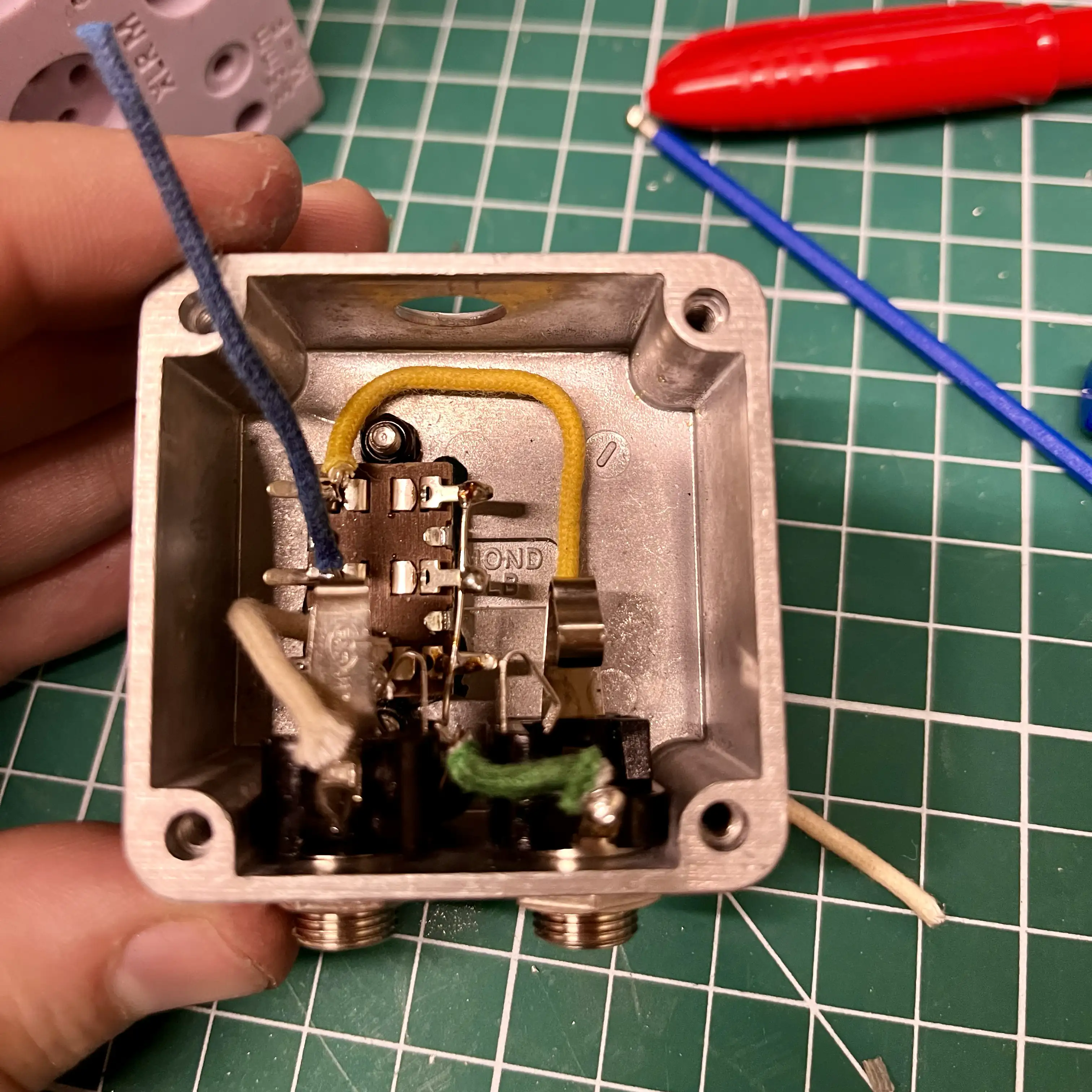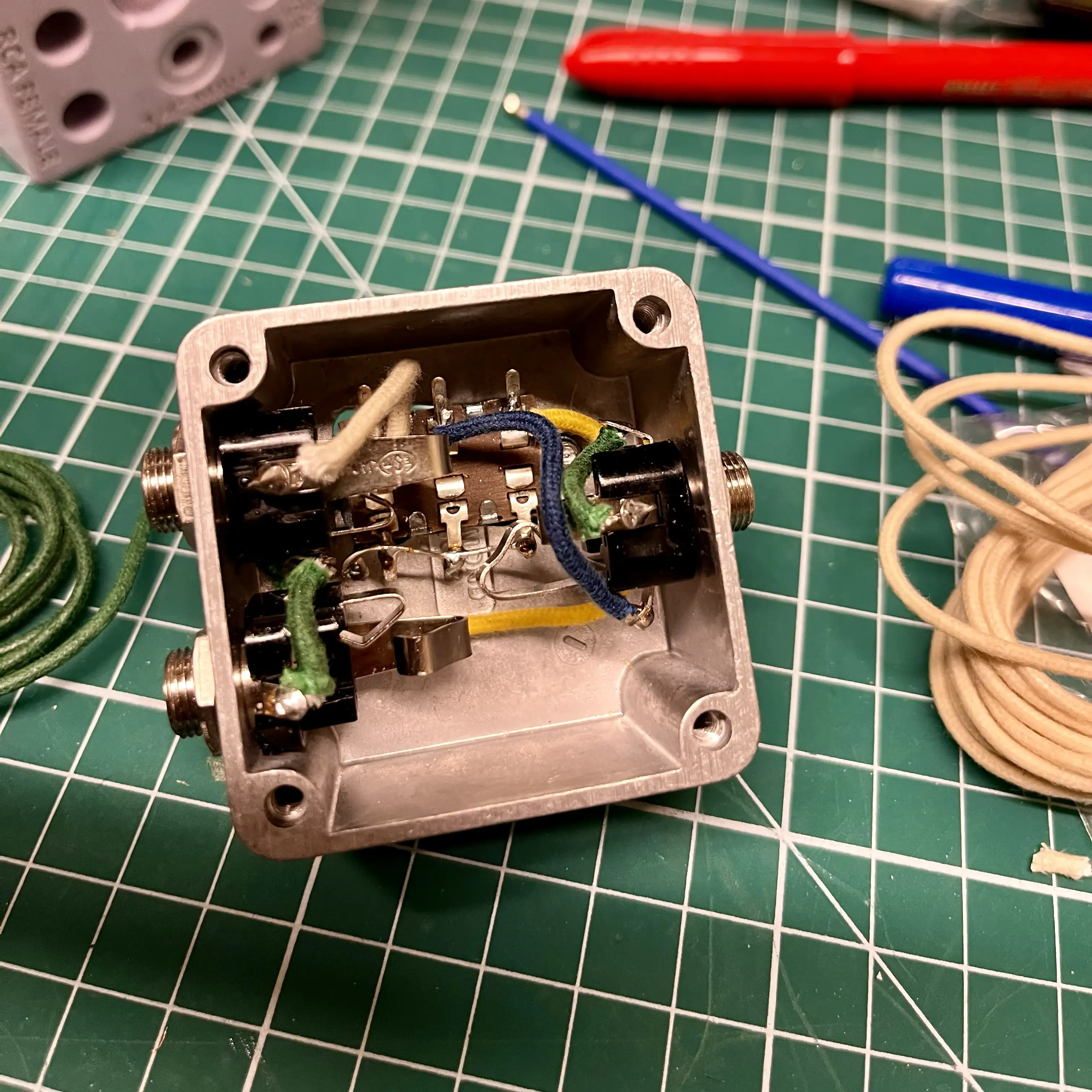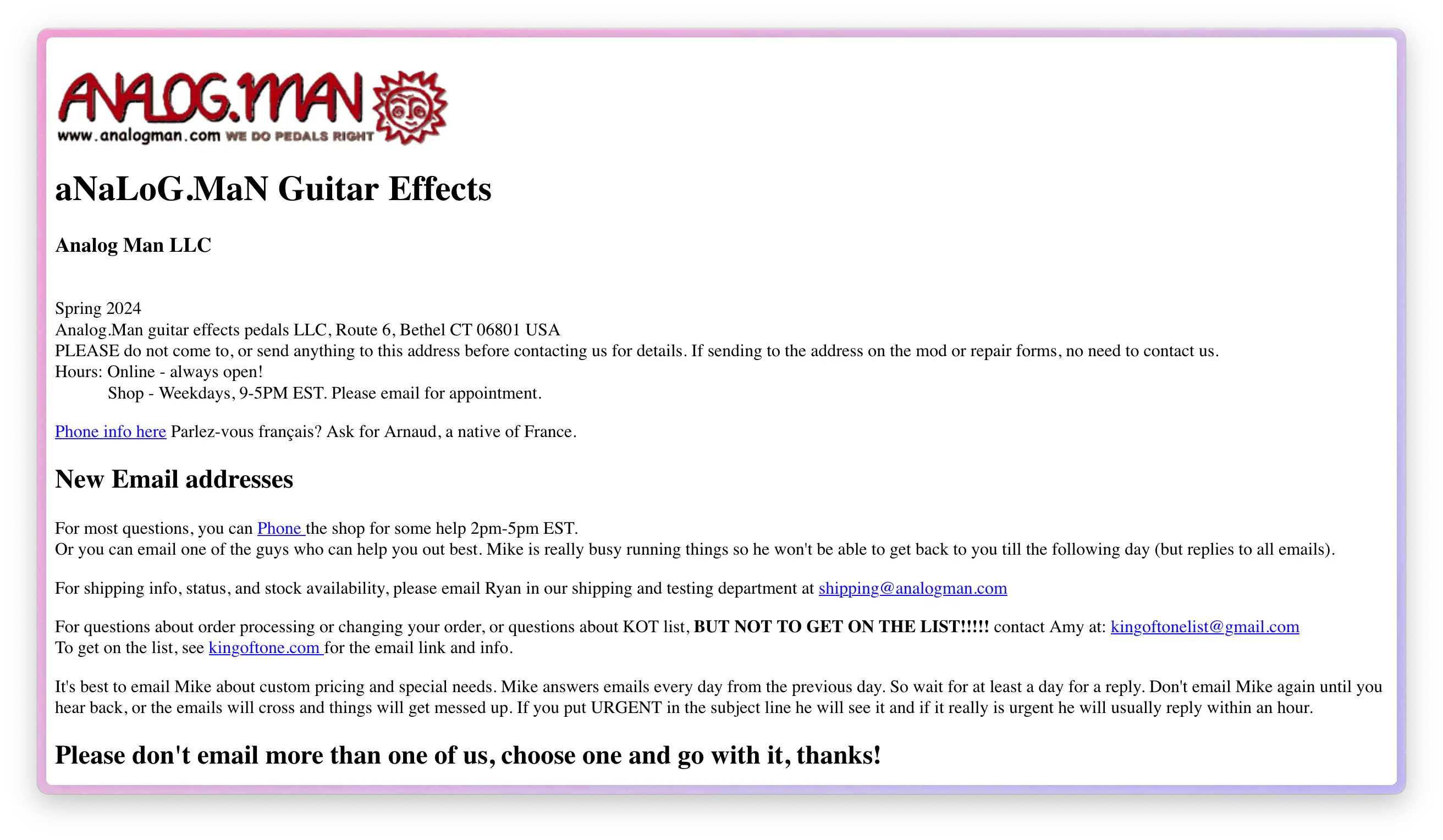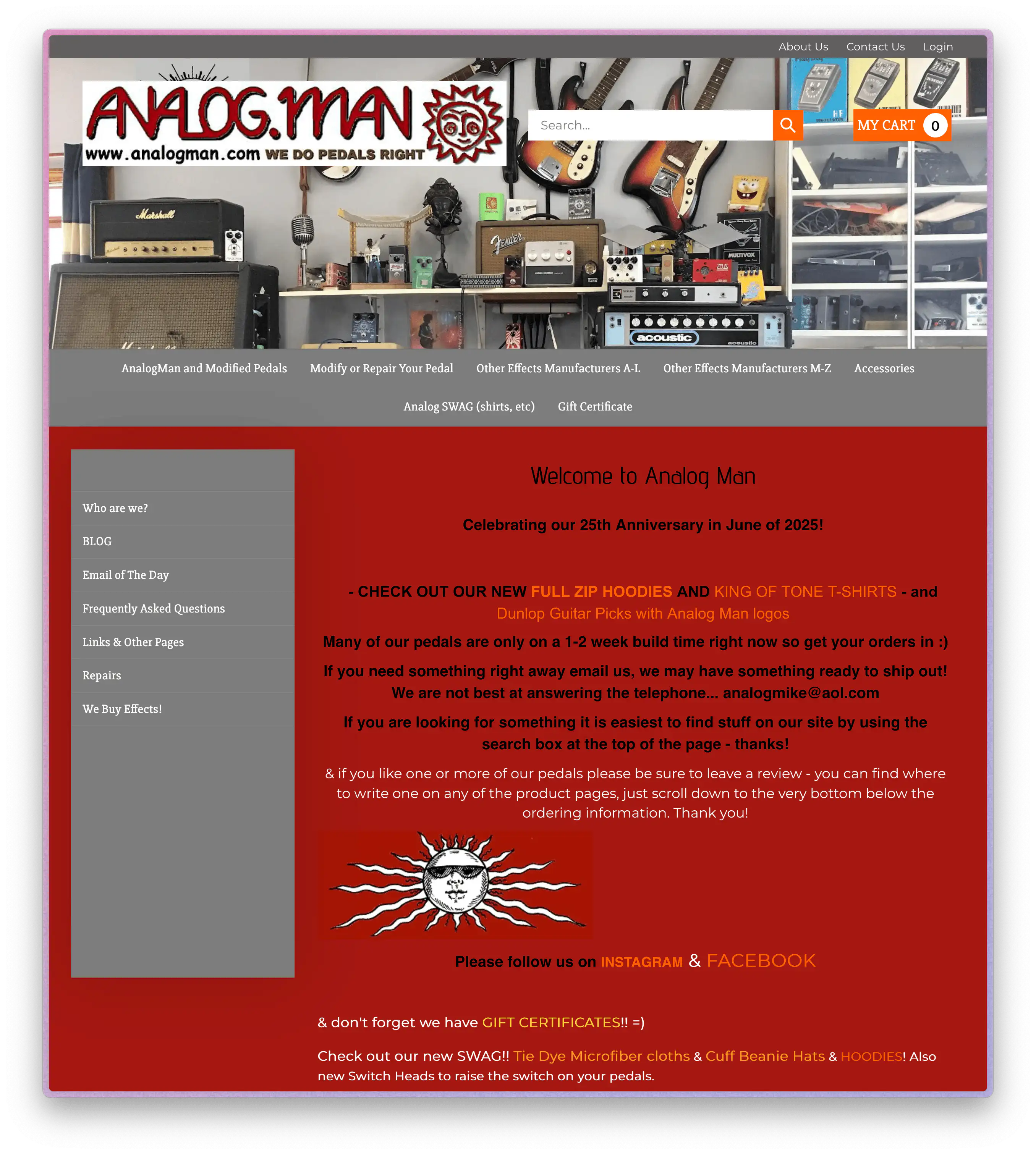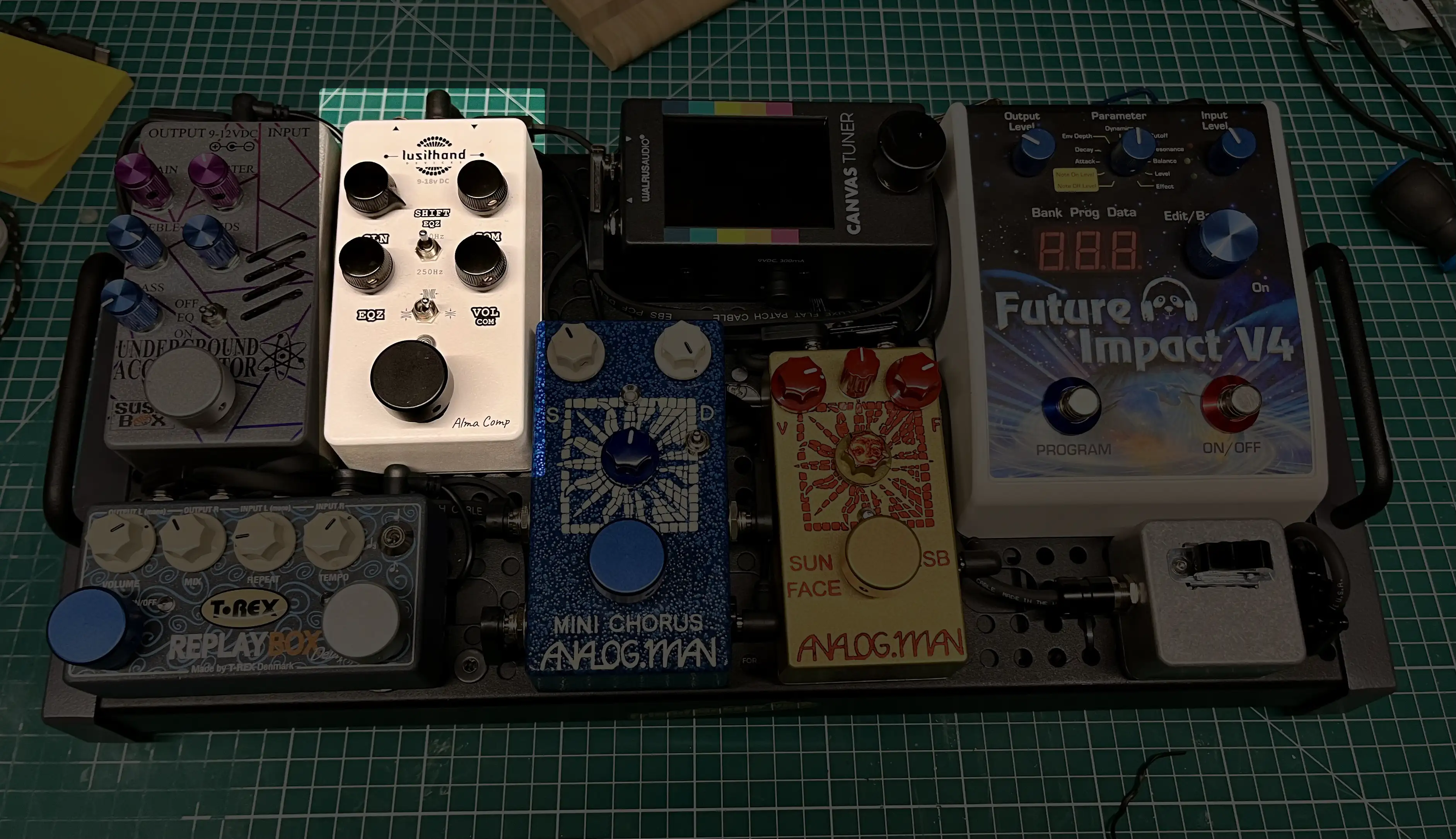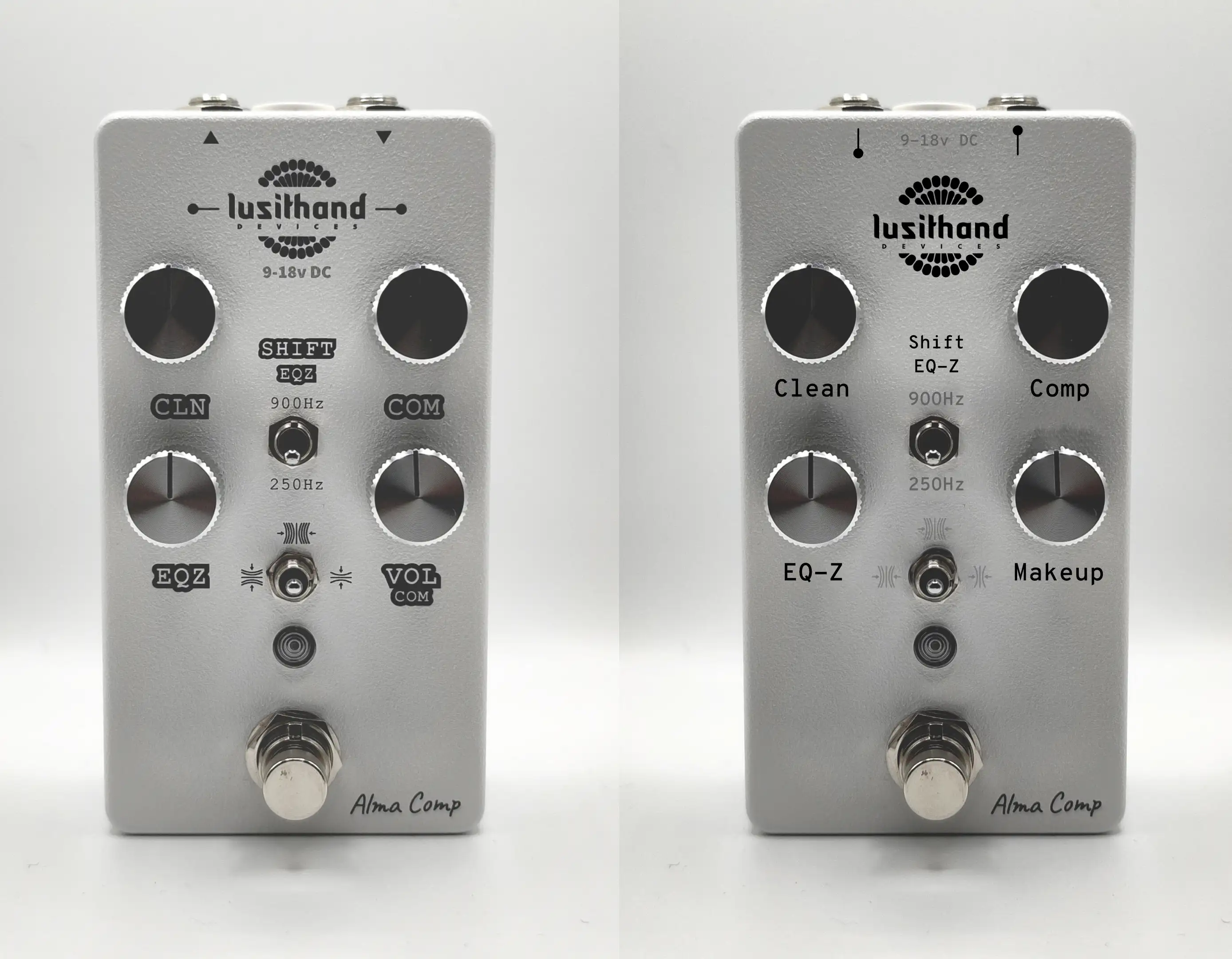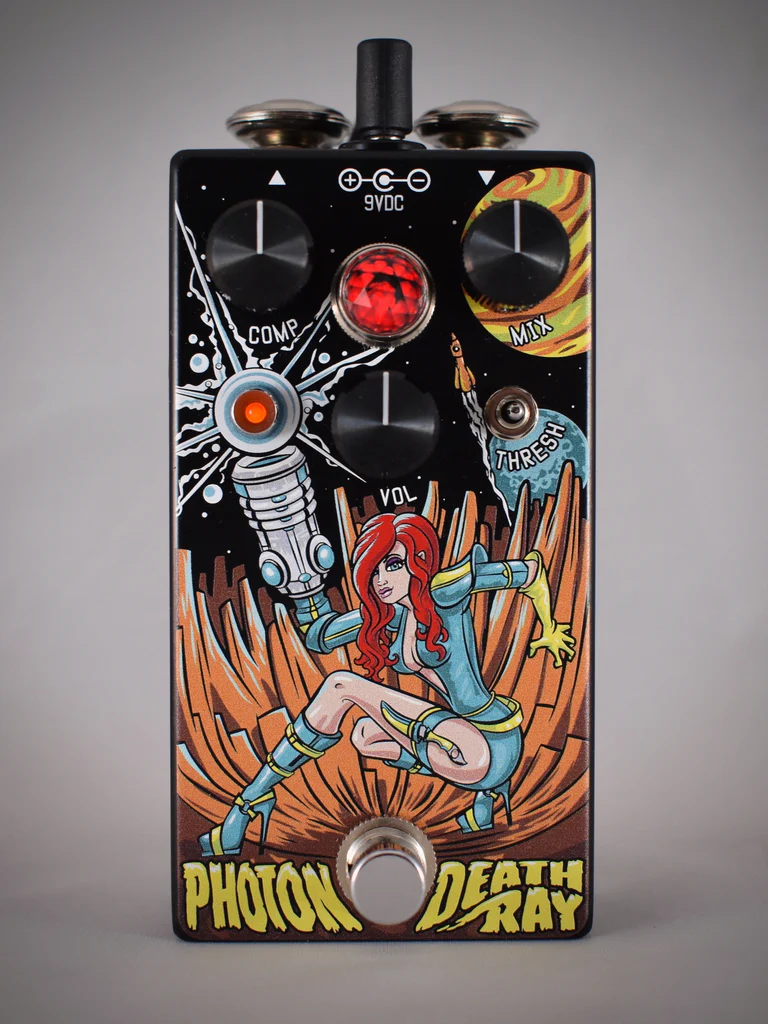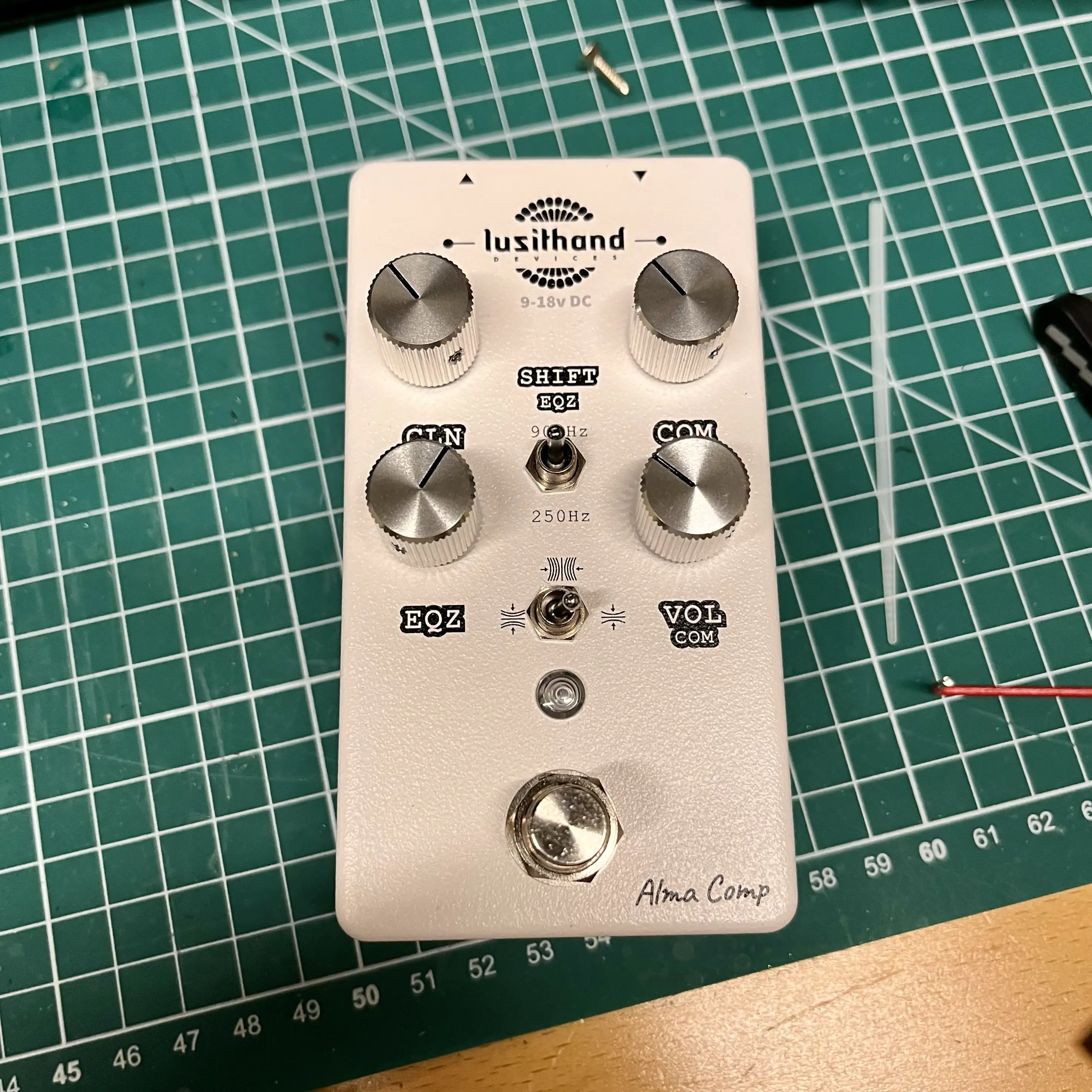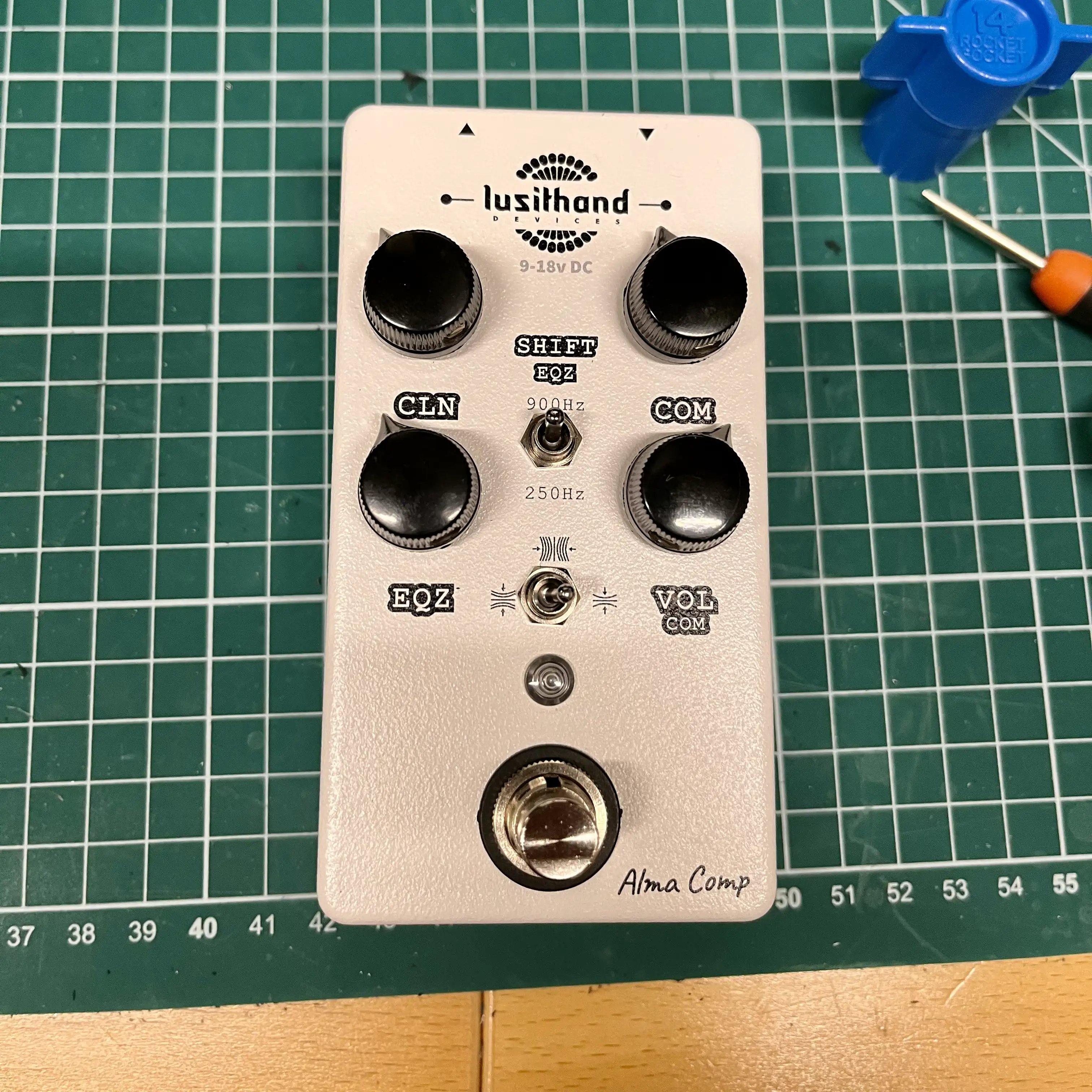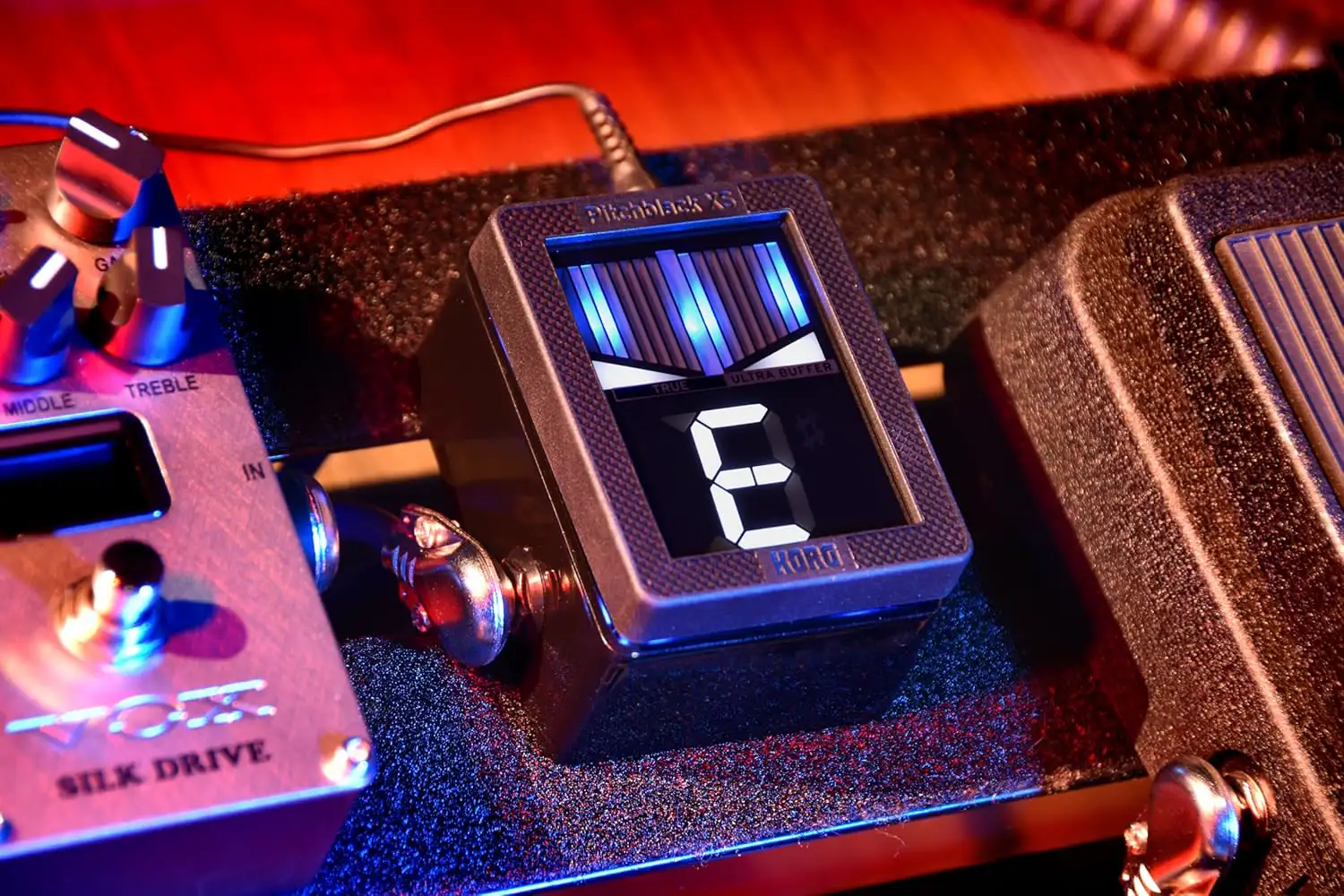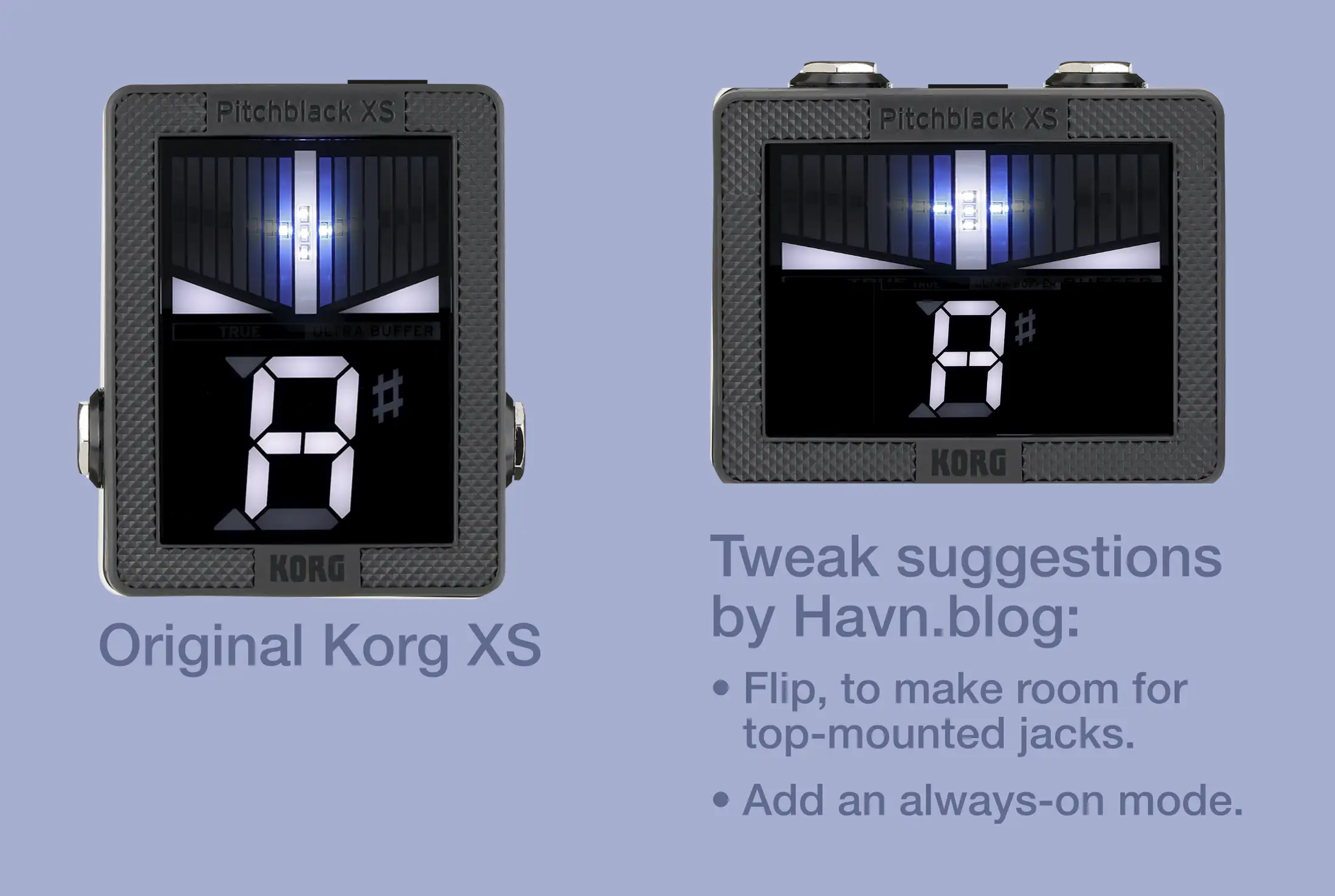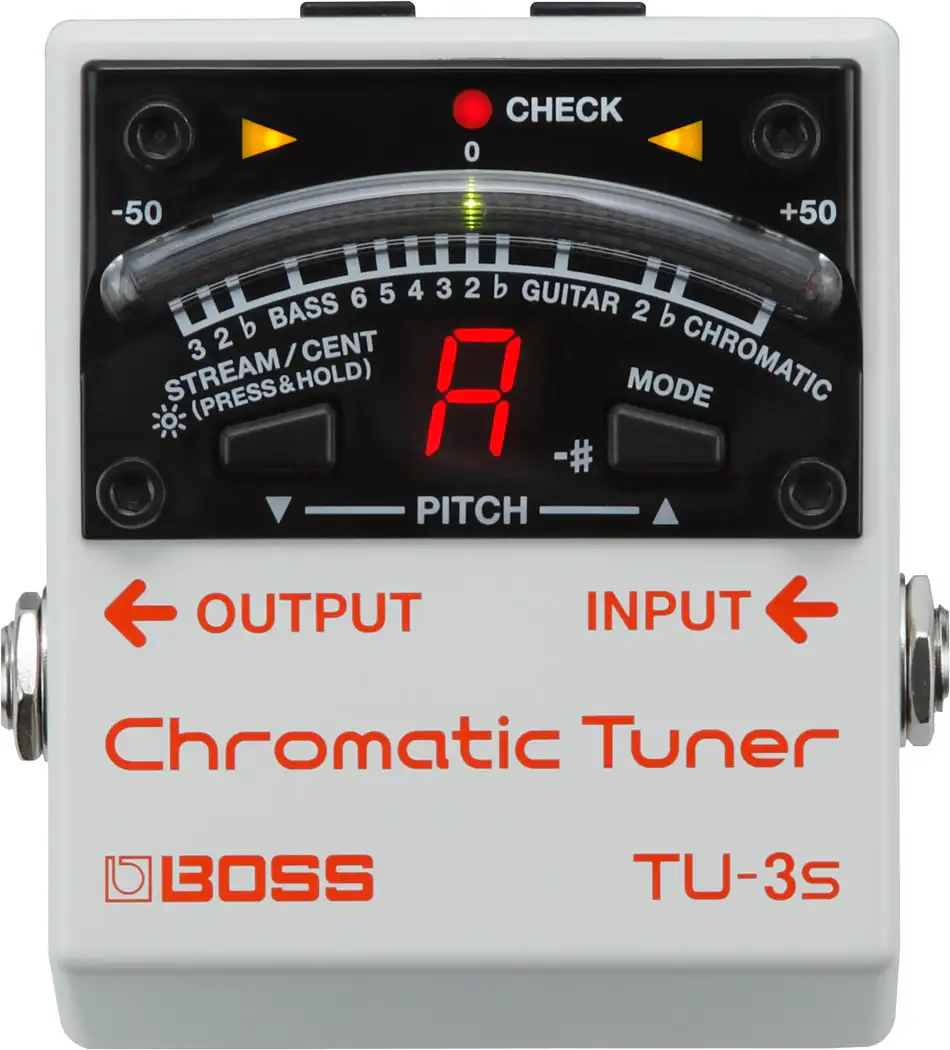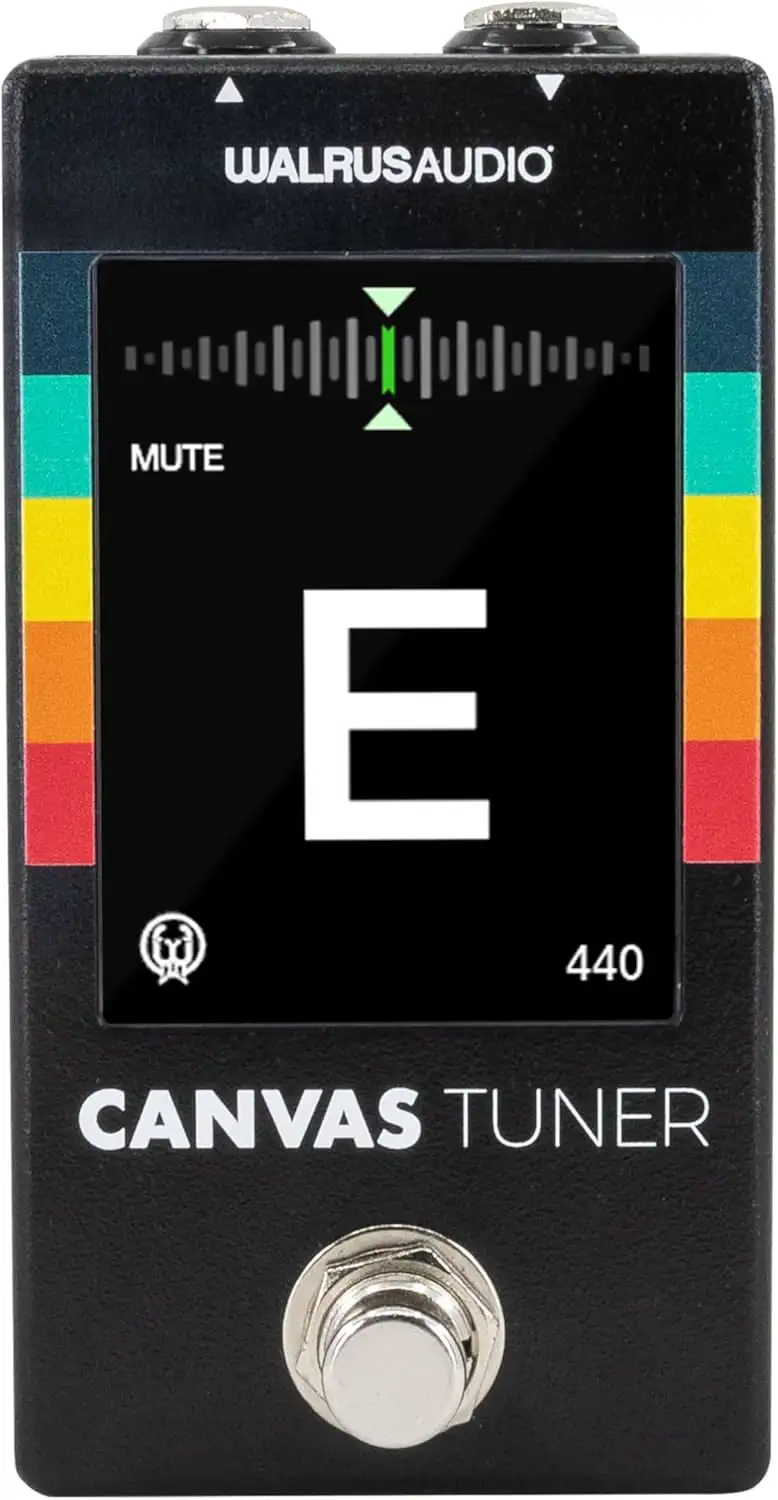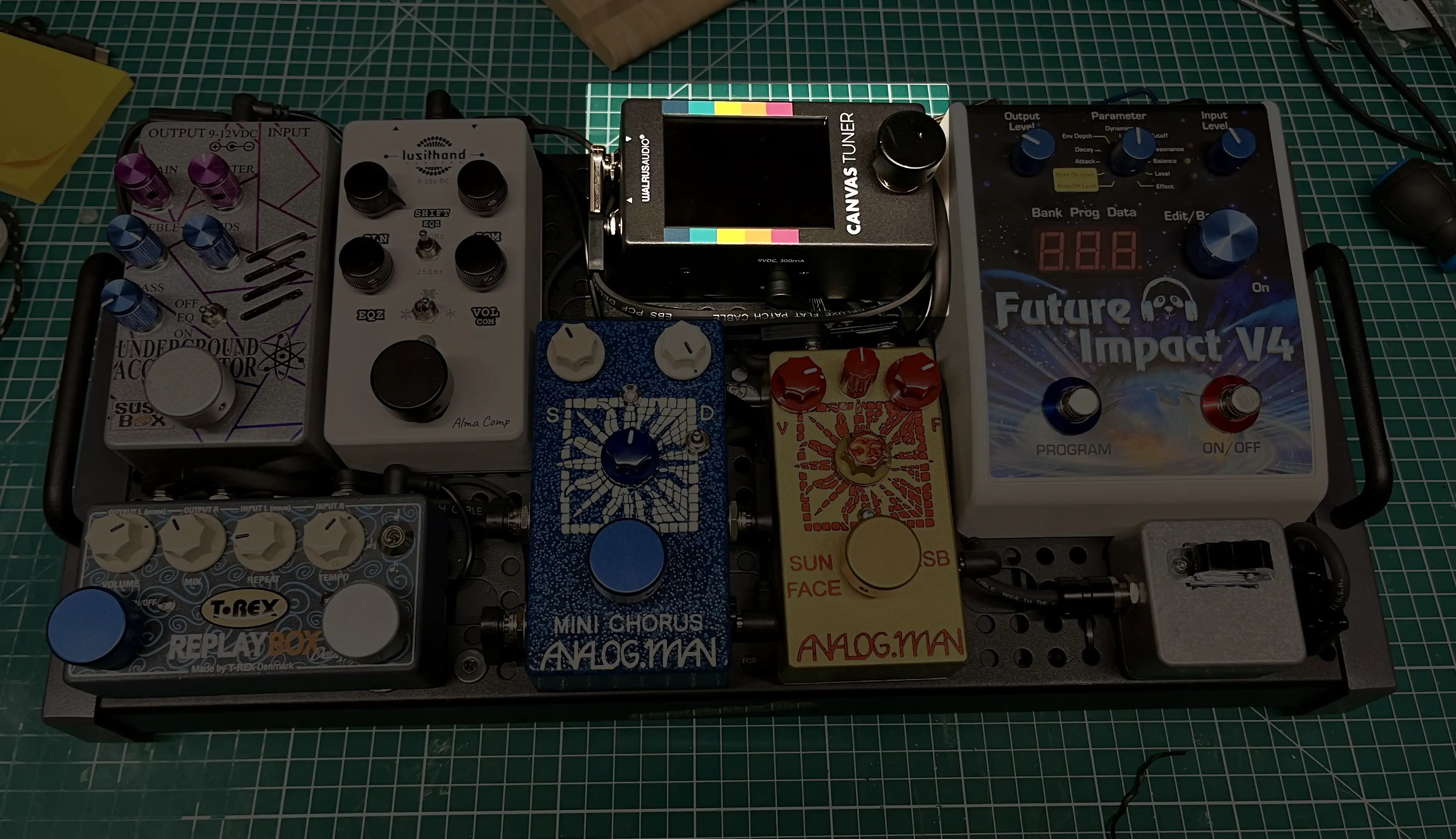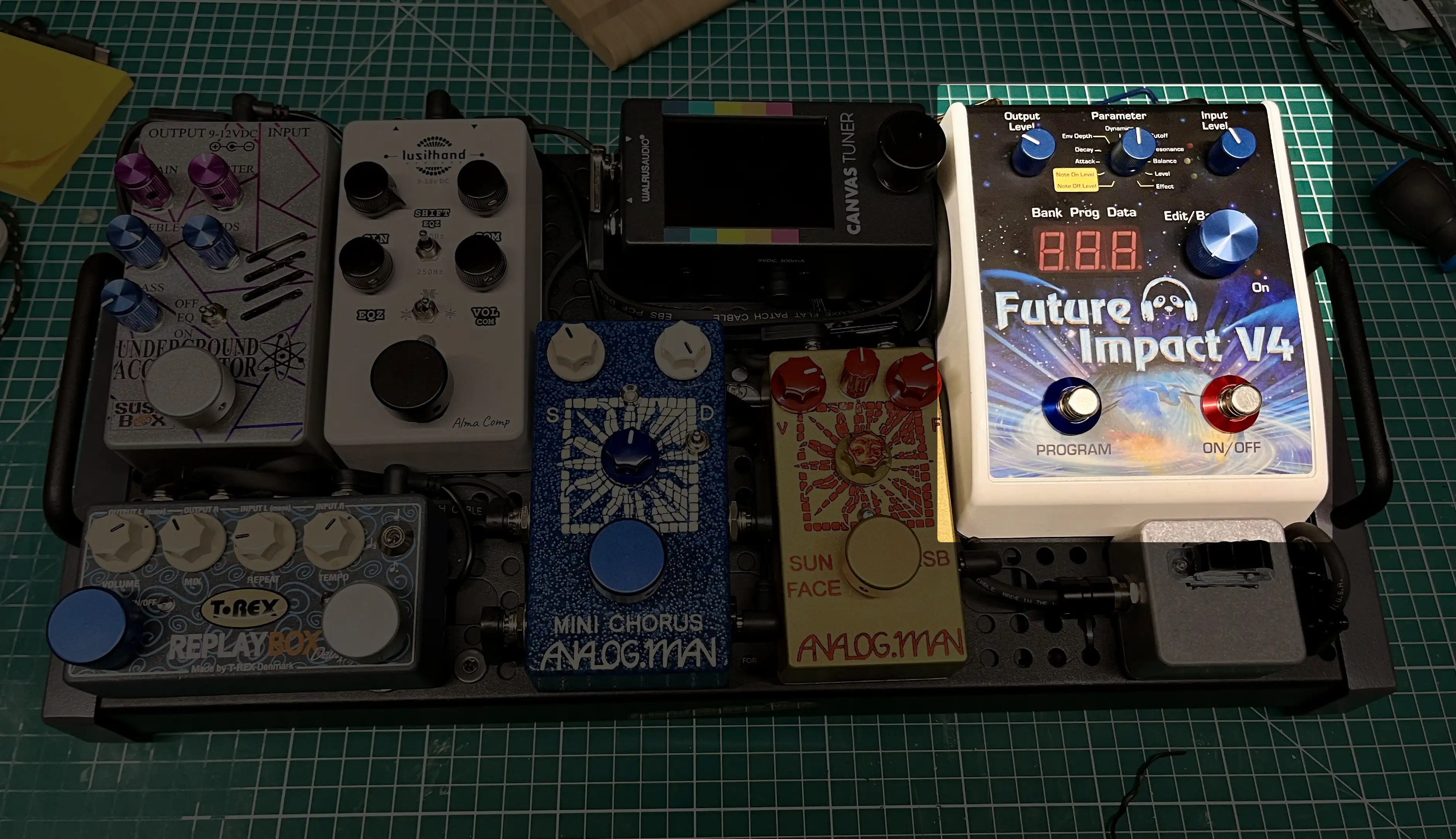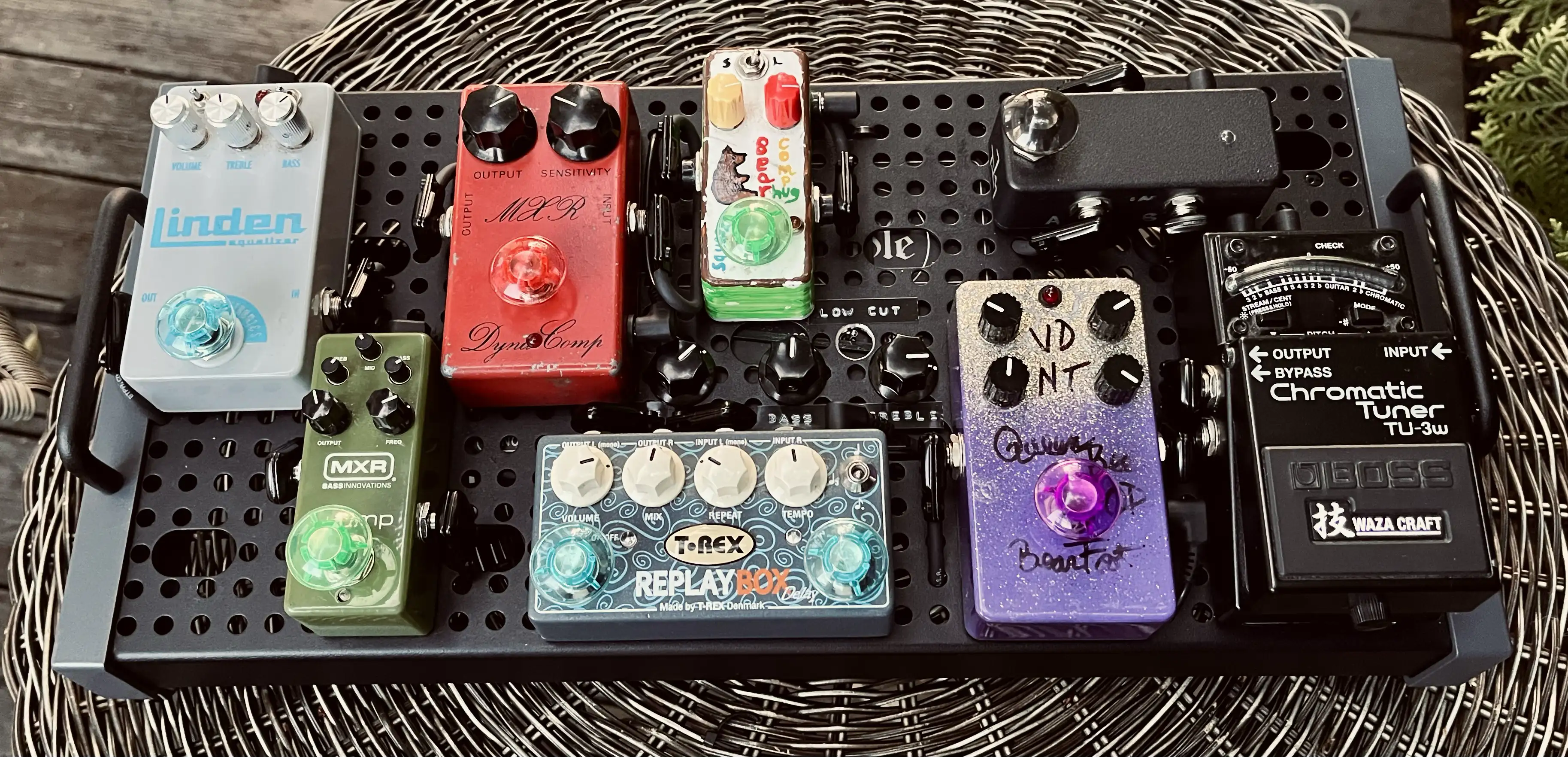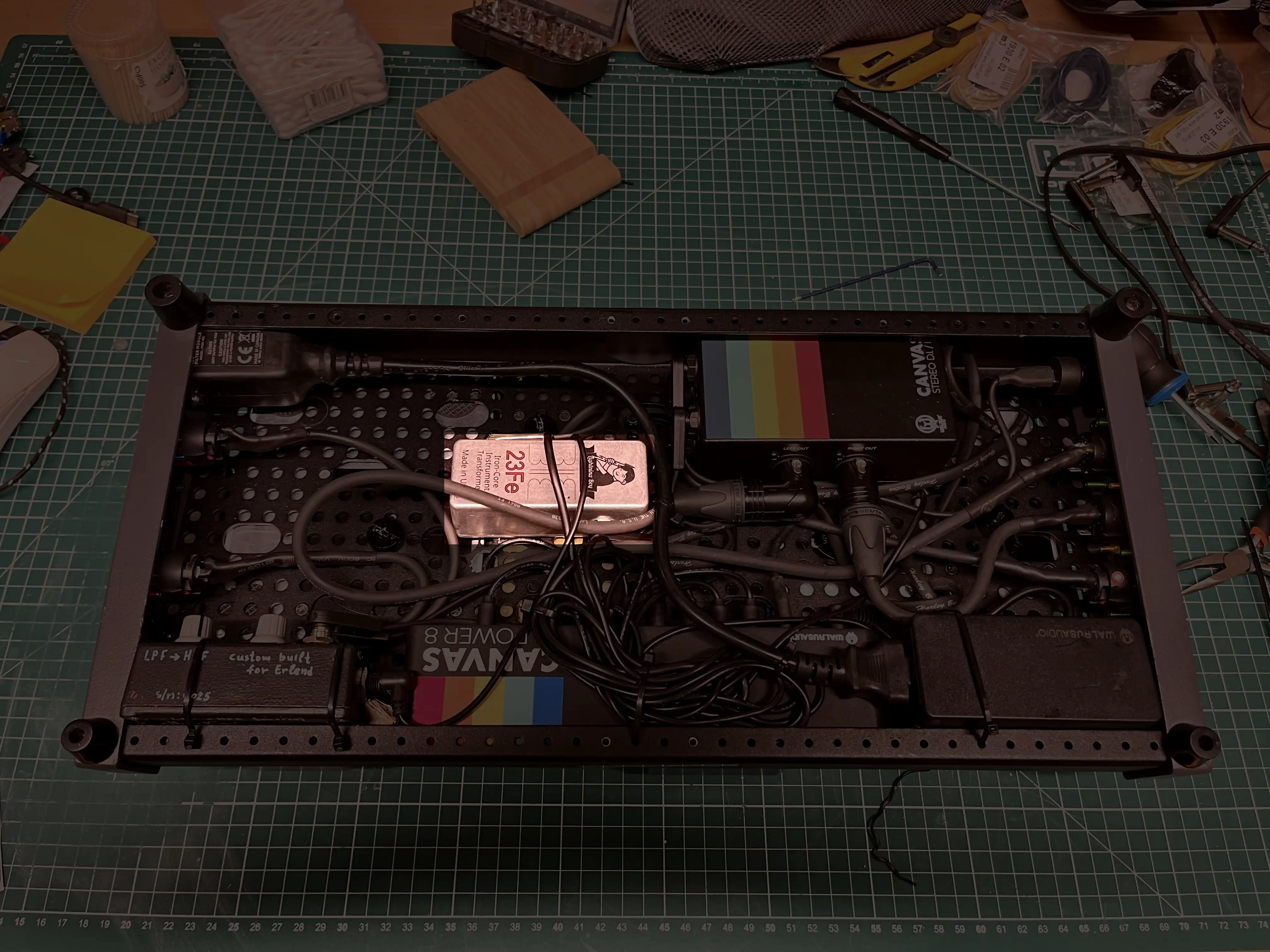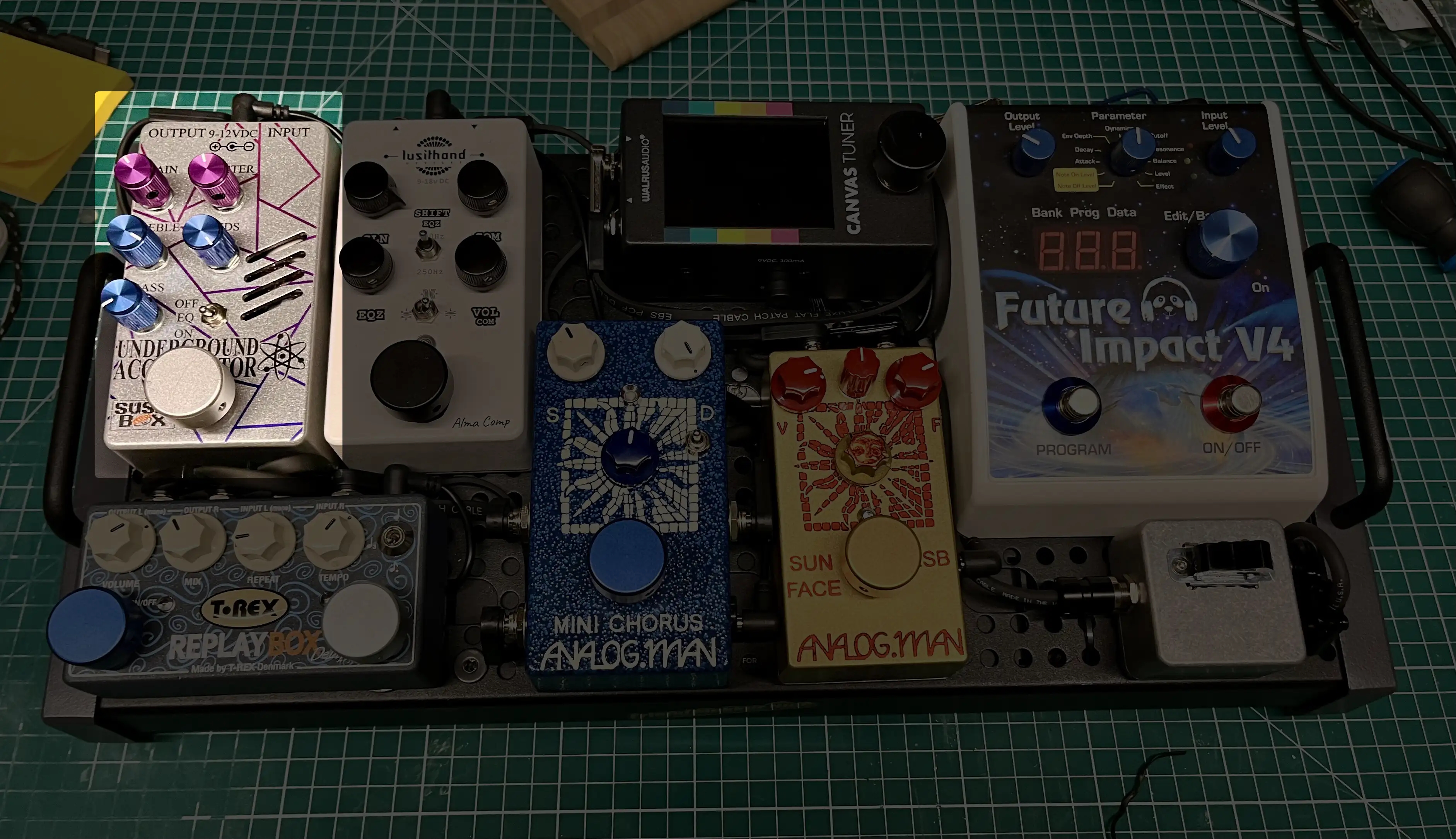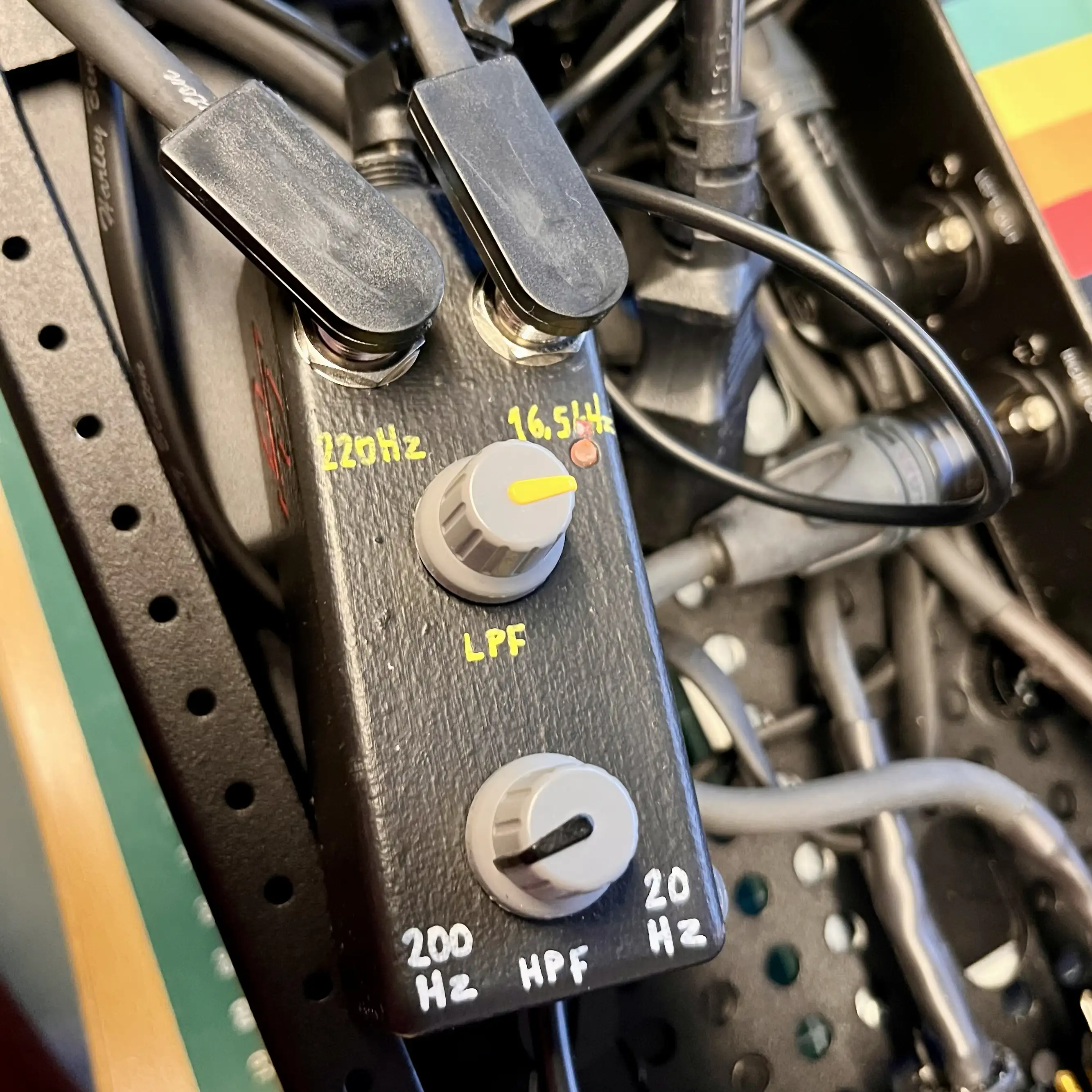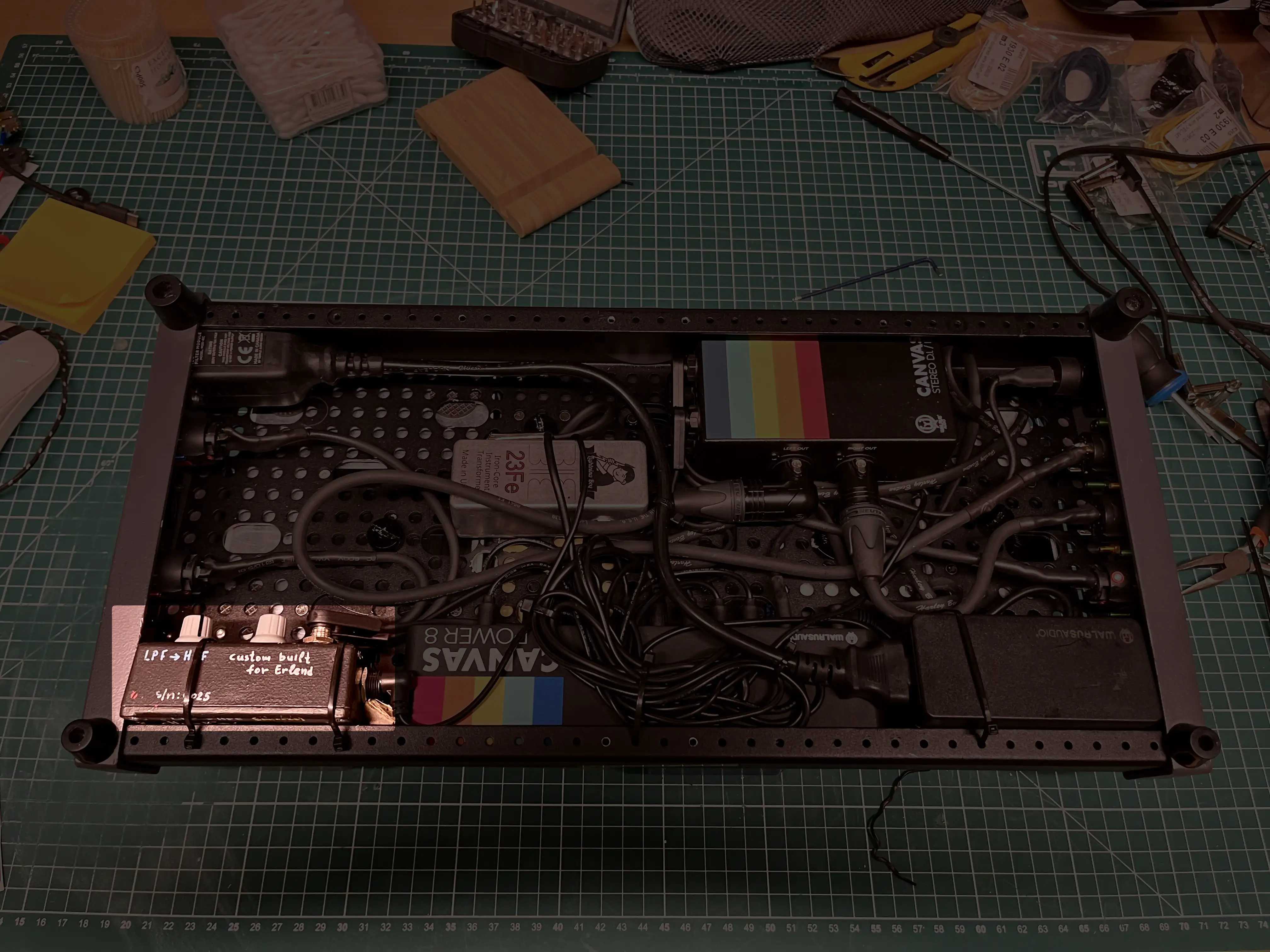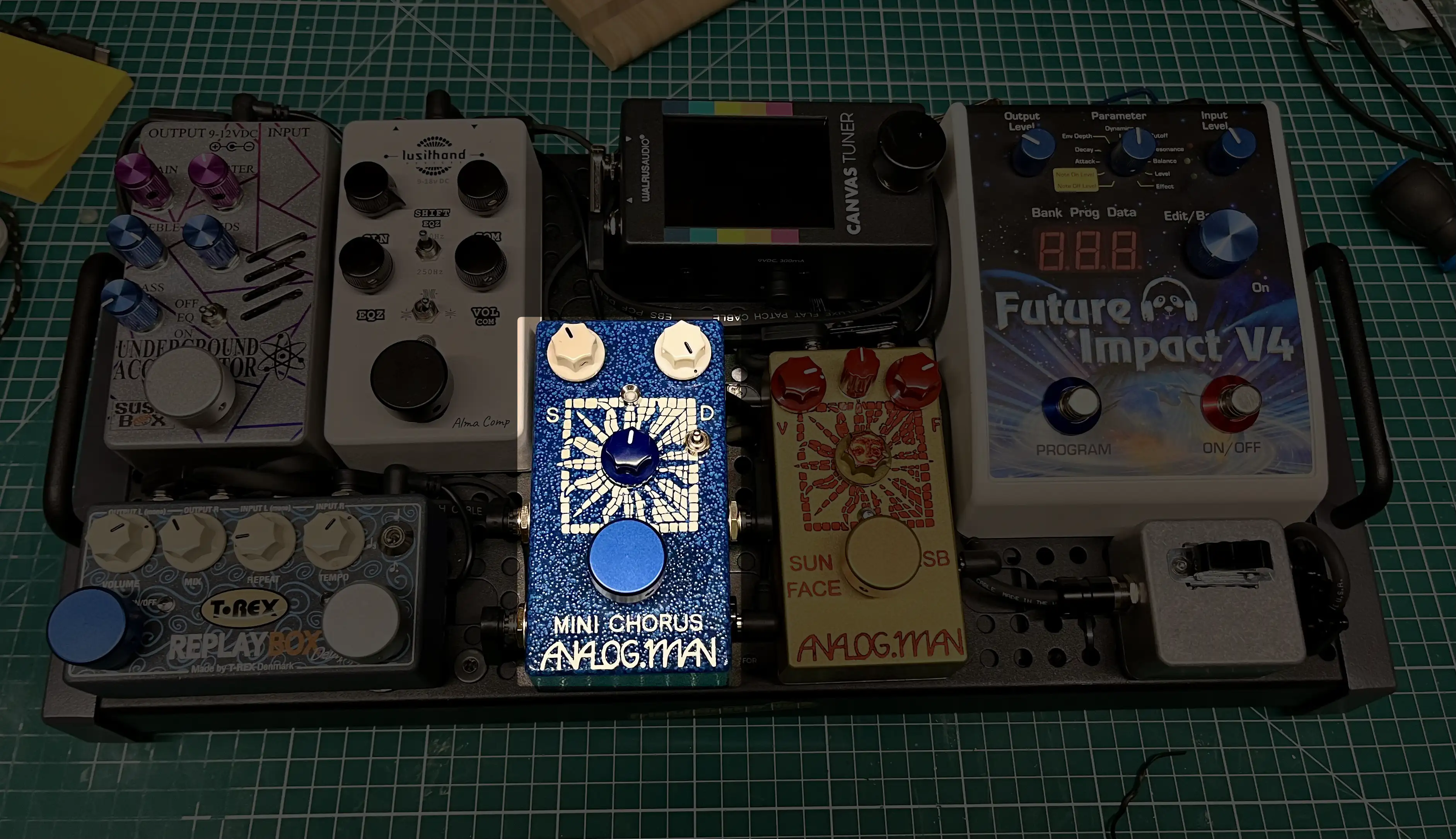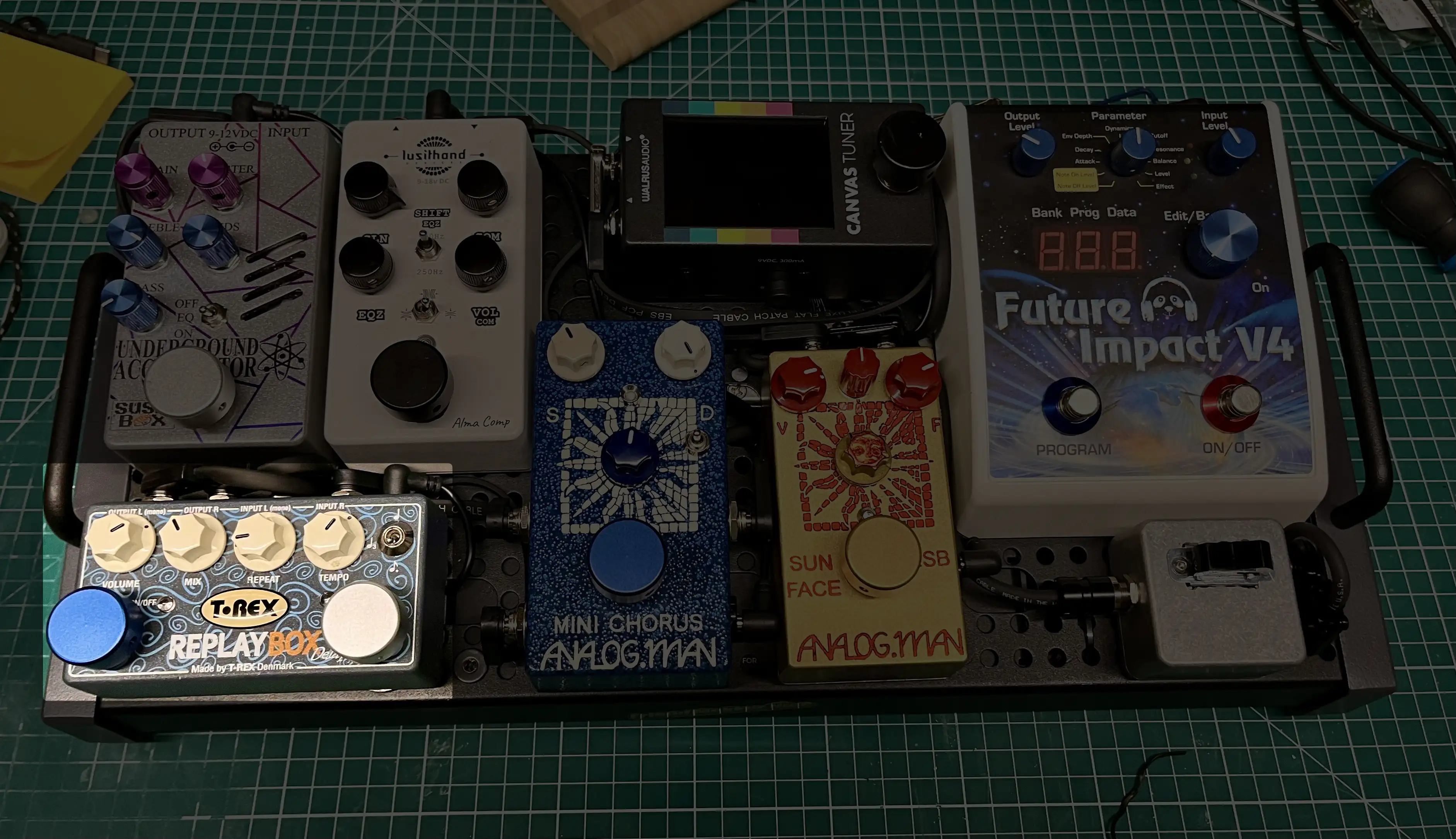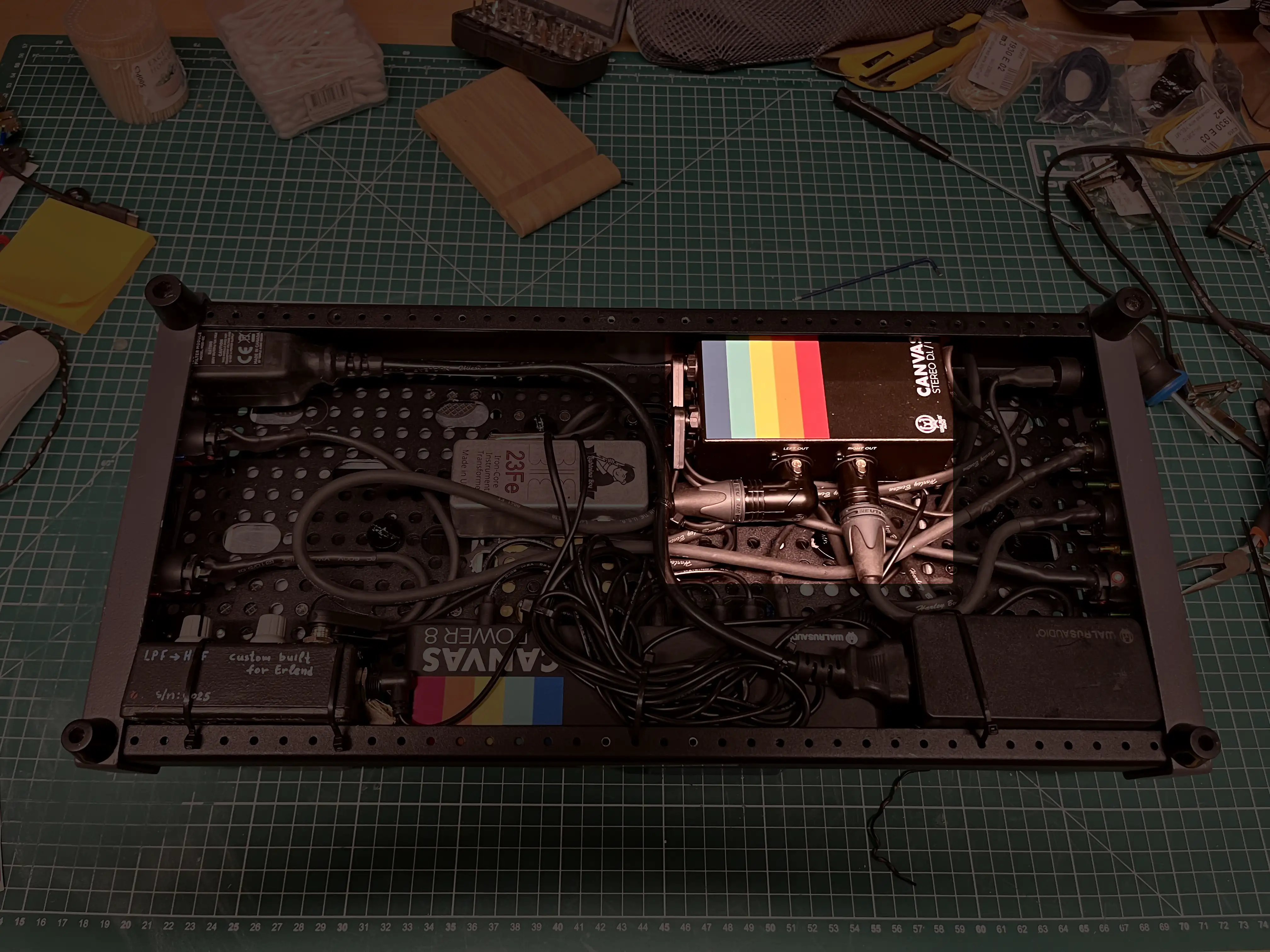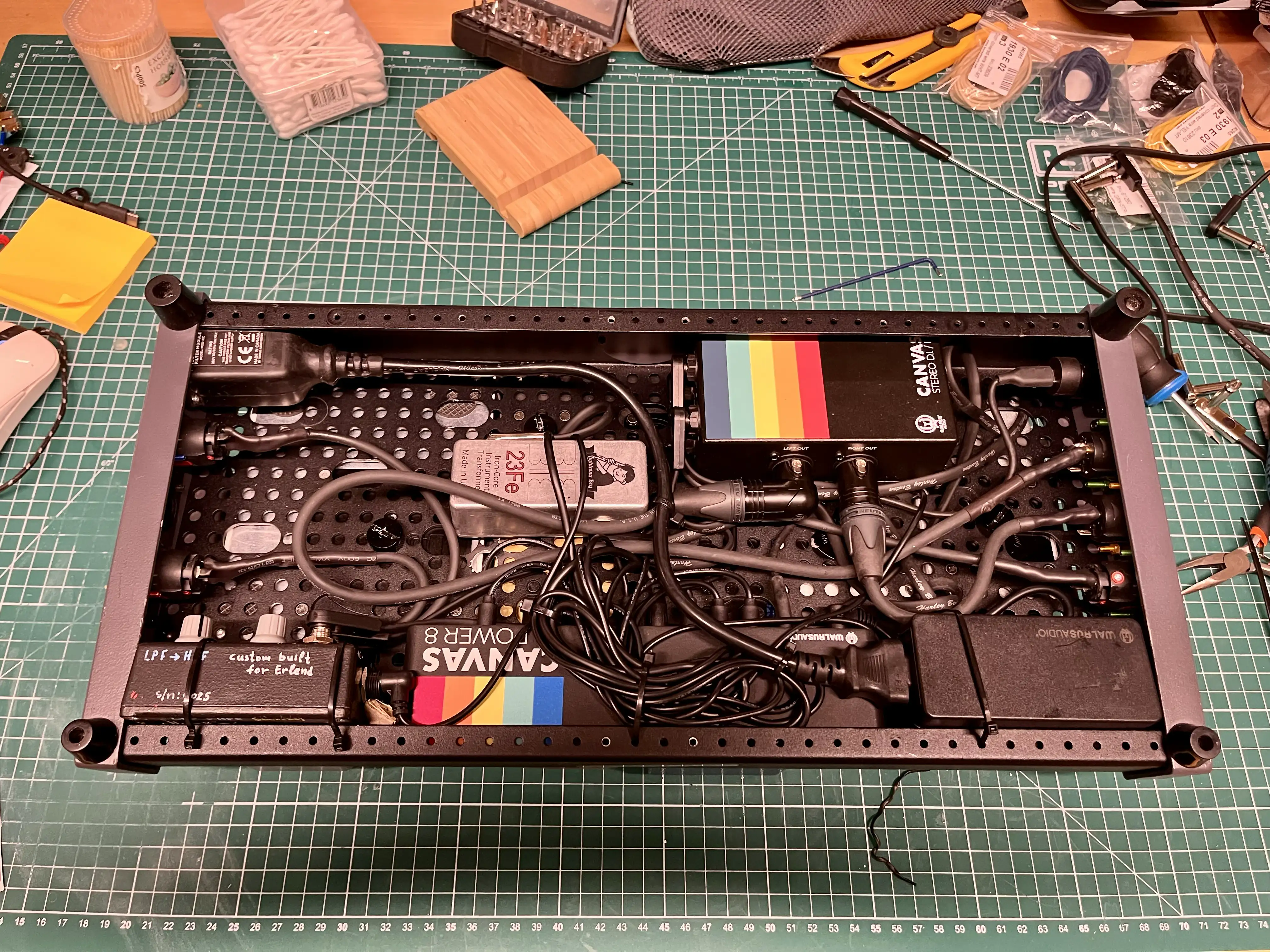My Compact Stereo Bass Pedalboard
On the side, I do a bit of pedalboard building. And finally, I’m done with my own board — so I wanted to present it here! I’ll also go into all the pedals and why I chose them.
Board and I/O
The board itself is the smallest size made by Temple Audio.
On the right side of the board, I can plug in power for all the pedals and Input A and B. I play with two basses live: My 1961 Fender P-Bass and Fender Japan Fretless Jazz Bass — and having them both plugged in is nice.
The power supply is the Canvas Power 8 🖇️ from Walrus Audio, which I’ll show when I get to the underside of the board.
The left side has a USB-C charging port, forwarded from the Canvas supply, balanced stereo out (the two XLRs), and a jack output from the left channel.
«Wait, stereo for bass??»
I only have two stereo effects: Chorus and delay. But I think it’s really cool! Lately, my «sound» has gone on to always involve some saturation (usually fuzz and/or a cranked preamp) and chorus. Here’s a little taste of the sound (isolated bass), from a demo my band is working on.
So, that’s why I send a stereo signal (with the XLRs) to front-of-house. However, I’ll never bother with two amps — so that’s why there’s only one jack output. My DI does have the option to sum the left and right channel, but that doesn’t work with my chorus. So what I do is that I just send Left to the amp, and then asks for the Right channel in my monitor.
The signal chain
In generic terms, here is my signal chain:
- AB switch
- Fuzz
- Compressor
- Tuner (and buffer)
- Synth pedal
- Flavourful transformer
- Tube preamp
- High-pass and low-pass filter pedal
- Chorus (stereo)
- Delay (stereo)
- DI (stereo)
And now, let’s go through them one by one!
AB switch: Homemade experiment
As I was building the board, I found myself running out of power outputs on my supply. I still have a power splitter or two — but I had some noise issues with some of them, so I wanted to reduce the amount of power I used.
One of the pedals that needed power was my AB switch, which only needed it to for an LED that showed which input was active. (The switching itself doesn’t need power.) So I wondered if I could build something that:
- Was even smaller than my old AB switch. (As you can see, the board is pretty cramped!)
- Had a switch that was visual in nature, so I wouldn’t need an LED, whilst still being foot-operable.
The best switch I could find was this thing. I didn’t have a good way to «drill» a square hole for it in the box, so excuse the messy hole — but it turned out like this (compared to my old switch):
It isn’t colour coded yet, though. It would be cool to have coloured screws, and/or at least some markings on the box. And, of course, it’s not as easy to see during a concert — but it works better than a regular foot-switch without an LED.
As this was just a proof-of-concept, and the first pedal I’ve built from scratch, I’m quite pleased. Here are some pictures from the inside during building:
Fuzz: Analogman Sun Face
The brand Analogman (and Mike Piera, the man behind it) is truly a treasure. I mean, the website (and logo) looks like this:
While the “new e-commerce shopping cart website” looks like this:
I’m not joking when saying that this looks so bad, you just know the pedals are good! 😎 And the first pedal in my chain (proper) is a Sun Face fuzz pedal. This is a faithful, yet modern, modification of the Fuzz Face pedal. When you order it, you can choose some options — and I chose:
- Top jacks,
- power jack,
- external Clean knob,
- and Sundial knob1.
I’ve later swapped the knobs for some red ones, and added an aluminum foot-switch cover.
Old-style fuzzes like this don’t play nice with buffers. So that’s why the buffer (in the tuner) is after this. (I don’t remember why I placed the compressor before the buffer as well, though… 🤷🏻♂️)
Compressor: Lusithand Alma Comp MKII
There are lots of great compressor options out there — many of them highlighted on this outstanding website. I landed on the Alma MKII, from Lusithand, for the following reasons: 2
- I wanted something that at least wasn’t larger, and that had top-mounted jacks.
- I love that it has clean blend and a tilt EQ. I don’t need more detailed compressor controls than the simple switch.3
- It has compressor metering in the LED.
- It sounds good, but not in a clean way. (I’d rather have more colour.)
Other strong contenders at the time, were Humboldt or Dakota from Niche Devices, Airchild 660 from J. Rockett, Photon Death Ray from Doc Lloyd, and Diamond Bass Comp/EQ.
I’m very pleased with the Alma, and always leave it on. But while I wish I didn’t care about it, I don’t like the way it looks… It’s manages the combo of being bland, while still not looking clean. (I think it has 5 different fonts on it..! And the MKIII isn’t much better.) I remember having some fun trying to clean up the design a bit:
The goal was to keep “the same” design, but just clean it up a bit. So I still don’t love it, hehe. I mean, look at something like the Photon Death Ray 😍:
I did swap the knobs though (and some stuff by the foot-switch — which now it also has a topper, as you can see in the photo above). And I like the “panda look”, that gave it some more personality at least:
Tuner: Walrus Audio Canvas Tuner
I have strong feelings when it comes to pedal tuners. They’re something every pedalboard needs — but it’s difficult to find one that’s precisely the way I want.
- Most tuners have a foot-switch so you can mute while you tune — and I know this sounds sensible (and in most cases is). However, If the board has a volume pedal and/or an AB switch, I’d rather mute with those. These need to be accessible anyway — so then I’d rather stick the tuner somewhere visible, but inaccessible. And for this to work, the tuner has to have an “always-on mode”4 — and at this point, the foot-switch is just a waste of space.
- It should have a good buffer. (But probably one that can also be turned off.)
- It also has to be accurate enough — but I don’t need Peterson level accuracy.
- The visibility also needs to be good.
The quite new Korg XS tuner 🖇️ 👆🏻 is so close to being perfect… (It even has a bass version 🖇️!)
The visibility is fantastic, and they’ve done something brilliant (and original): The entire frame is the foot-switch. You can also toggle the buffer.
However, it can’t be set to be always-on! 🤦🏻♂️ There’s no way to tune with it without muting the signal. Look at the promo picture above, and how beautifully it’s tucked away at the top of the board. But you still need to be able to step on it…
Here’s how (relatively) easily, the Korg XS could become the perfect tuner (IMO):
The first change is easy: Add a dip-switch for an always-on mode.
Another slight issue is the lack of top-mounted jacks. (It’s always more efficient to have all I/O on the same side.) So, here’s what I’d do:
The tuner I actually ended up with
Walrus Audio 🖇️ is, in general, a great brand — and I especially love the Canvas series (which I’ve already linked to, with my power supply). And even though it doesn’t fit everything I asked for above, I went for the Canvas Tuner 🖇️.
On my board, I actually do need to use the tuner to mute — so it isn’t a con that it has a regular foot-switch. (It can be set to be always-on, btw.)
The buffer and visibility is good, and the screen allows for some interesting features. These are the two I use:
- It has a built-in timer, which I use to time our concerts.
- You can flip it to the orientation you want.
The cons are that the power jack is on the side (but the jacks are top-mounted), and that it requires a lot of power (for a tuner).
Synth pedal: Panda Audio Future Impact v4
Future Impact is a pedal inspired by the legendary Akai Deep Impact, with a bunch of added goodies.
Speaking of «camp», I love the way this looks. (Especially after I swapped the knobs, and added some colour to the foot-switches.) And that’s a good thing, as I just found out Panda Audio just released a new, and much more compact version of this pedal. 😬 That would’ve been a godsend on a small pedalboard like mine…
Moreover, to be honest, I haven’t got around to spending a lot of time playing with this one. (For instance, I am keen to explore the octave options). Currently, I just use it live for songs where we recorded with a synth bass.
Flavourful transformer and tube preamp: Lightning Boy 23Fe & Sushi Box Underground Accelerator
To explain why I lumped these two together, let me show my previous pedalboard:
If you look closely, you can see that I had mounted the wonderful Noble Preamp underneath the board, with the knobs poking out. In addition to being my DI, this was also my power supply. I looooved the way it sounded — but my pedal needs outgrew the power it could provide. This is what sparked the rebuild.
It’s also very expensive, so I couldn’t afford to keep it while still building my board. I also wanted to add stereo, so I needed another DI. All-in-all it was too expensive, too large, too weak (in terms of supplying power), and too mono for my evolving needs.
I considered buying two smaller tube DIs (for stereo). But instead I went for a clean and “sterile” DI (which I’ll get back to), and adding the mojo beforehand.
Lightning Boy Audio creates a lot of cool gear, including some funky transformers, like my 23Fe (not the new and improved 23Fe+ 😔).
The 23Fe was developed in 2023 in an effort to create a really bad transformer, while retaining somewhat of a decent frequency response, minimal insertion loss, and a robust enough build to handle getting tossed around without breakage. Technically speaking, the worse a transformer performs, the more colorful it is.
— Lightning Boy
This sits below my pedalboard, and my signal always goes through it. I preferred having it before the preamp, and it gives some subtle colour and a slightly different feel while playing.
For my preamp, I went for the Underground Accelerator by Sushi Box. This one is also always-on, and thus always give me tube-goodness and tone-shaping ability. I like it! Things doesn’t sound quite as good as it did with the Noble — but still great.
Here's a way the Underground Accelerator could've been really cool for me:
As you might've seen, the UA has a gain knob. This makes it so it can be a really nice overdrive pedal. But as I want it to always be on, I completely lose this feature.
My dream version of this pedal would be something close to a compact version of the Dreamcatcher:
It would still have Treble, Mids and Bass — but it would need two sets of Gain and Master knobs. It could have a toggle (perhaps instead of the EQ one) to bypass the pedal, and then the footswitch would swap between the two sets of Gain/Master.
This way I could set one of them in overdrive, while still choosing if I want to boost the volume or not.
HPF/LPF pedal: Custom from dpFX
The last part of my mono signal, is a custom pedal by dpFX.
As it’s just a set-and-forget kind of pedal, I love that I can just stuff it under the board.
Chorus: Analogman Mini Chorus (stereo)
For the first stereo part, we’re back to our friend Analogman. And the Mini Chorus (stereo, with blend knob and depth toggle) simply sounds wonderful. I want to leave it on all the time.
Delay: T-Rex Replay Box (stereo)
In general, I wouldn’t call this 🖇️ a great delay. For most purposes, it’s simply far too clean and sterile. (I vastly prefer more tape/analog sounding delays.) However, for me, it’s perfect:
- For bass, as opposed to guitar, it being so clean is a boon. The delay types I like for guitar can become too muddy — and my signal usually already has plenty of saturation and modulation.
- It packs in stereo and tap tempo in an unbeatable form factor. I like that it’s horizontal, as it has two foot-switches (which become cramped on vertical pedals), and it fits where other pedals don’t.
DI: Walrus Audio Canvas Stereo DI
The aforementioned sterile DI, is also from Walrus Audio’s Canvas series: The Direct Box and Line Isolator 🖇️. This is also tucked beneath, and set to Line Isolator mode (meaning it sends a hotter signal compared to DI).
As mentioned, I don’t sum the Left and Right channels for the jack, as this ruins the chorus effect.5
This doesn’t really do anything for my sound — but it’s compact and just what I need.
Perfect for my needs
I’m very pleased with the final result, and that I was able to cram so many features into such a small board:
- Two switchable inputs
- Everything powered by one cable (including a USB-C charging port)
- Tuner, fuzz, compressor, tube goodness and tone-shaping, synth effects, chorus, delay, and HPF/LPF
- Balanced stereo output (and jack output as well)
The only thing, I’m missing, is that I wouldn’t mind a simple pedal I could hit to adjust my EQ while switching between a pick and fingers. I tried to make a Mr. White from Henretta Engineering to work for this — but it wouldn’t quite sound right. 6 So I sacrificed it for space and power. I’d also like it if the preamp could’ve been an overdrive pedal as well.
Placing the power brick for the Canvas supply was also a challenge — but I managed to find a spot where it wouldn’t create noise. (The tube preamp and compressor were the worst combos here.)
And the underside is a bit too cramped and messy — but that’s the price you pay for so many features. Also, I hate «Instagram tidy cable runs» that make it so the board is impossible to tweak down the line…
—-
I just love making pedalboards! So I hope I’ll be able to do it even more for others. The first thing is that I need to become better at advertising…
-
External bias control. ↩︎
-
Turns out MKIII just got released! None of the new features appeal to me, so I’m lucky there. But it seems great as well, and is what you would be getting if you bought one now. ↩︎
-
I’d rather not faff with attack, release, etc. ↩︎
-
Or you need a sparate tuner-out on the AB switch/volume pedal. But this takes up space, and now your volume pedal should probably be active, which increases the power needs… ↩︎
-
I just send Left to my amp, and ask for Right as my monitor. ↩︎
-
I would probably need a version tweaked for bass. ↩︎
